Karen Lamassonne: Ruido / Noise
Sep 14 2022 - Jan 08 2023
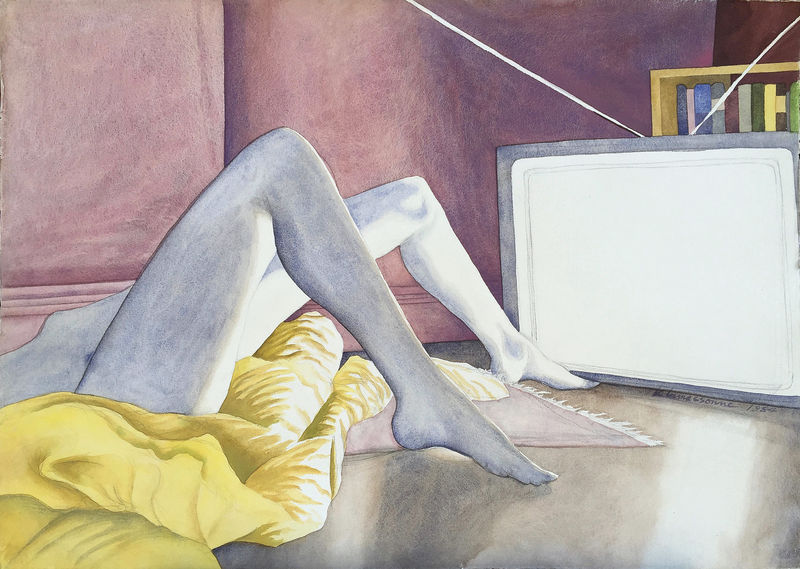
Download Press Release
Download Checklist and Map
Ruido / Noise is the first international survey of the work of Colombian American artist Karen Lamassonne. Lamassonne was a central figure in the male-dominated Cali and Bogotá art and film scenes of the 1970s and 80s, and throughout her career has maintained a focus on self-portraiture and depictions of intimacy. Her practice was initially centered on painting, yet her involvement with cinema led to an engagement with video, photography, animation, storyboarding and art direction. Spanning from her early years to today, the exhibit at Swiss Institute shows Lamassonne’s radical, longstanding commitment to portraying women as desiring subjects.
In a watercolor series from early in Lamassonne’s career entitled Baños (1978-81), a naked woman is seen in a decoratively tiled bathroom, an atmosphere of cool privacy. Lamassonne has tended to describe these paintings as self-portraits, though the figure is usually anonymized: shown only from the shoulders down or from the back, posed on toilets and bidets, and in showers and baths. Though the washy pigment is delicate, there is a matter-of-factness to the paintings, which position bodies between dirtiness and cleanliness, between excretions and ablutions. An exhibition of the works in 1979 at the Galería del Club de Ejecutivos in Cali was prematurely shut down because of complaints from some of the “executives.” In later self-portraits, Lamassonne pictures herself in relation to other domestic spaces, as though her environment is an extension of her subjectivity, using mirrors to fragment her representation across the space.
In the 1980s, Lamsassonne became involved with a number of filmmakers known as the Grupo de Cali (Cali Group), who often employed popular B-movie genres such as horror or crime to create political allegories that also skewered mainstream Colombian cinema. Lamassonne worked in many capacities on several of these films, notably Pura Sangre (1982), directed by her then-partner Luis Ospina, for which she was art director, assistant editor and made the storyboard, which is included in the exhibition. The profound influence of these filmmaking projects can be seen in her cinematic paintings such as the Cali series (1989), in which giant, noirishly rendered figures caress one another, dominating the lurid city skyline in scenes reminiscent of Attack of the 50-Foot Woman (dir. 1958 Nathan Juran).
Bringing several of these facets together, the exhibition features the first realization of an installation that Lamassonne proposed in 1984 entitled Ruido (Noise). Television screens playing an experimental video made while the artist lived in New York City one winter are used to light several paintings installed around them, which each depict a woman’s body illuminated by the glow of a TV. In this video of contrasts, the heat of a lone body is pitched against other environments and temperatures, eventually meeting the freezing city snow.
Lamasonne’s paintings, photographs and collages are characteristically guided by a search for spaces in which to be: locations where it is possible to express oneself and one’s sensuality, alone or with others. From the tiled bathrooms where a room of one’s own can be found behind locked doors, to the urban bridges and parks seen in the Cali paintings, Lamassonne’s work presents varied possibilities for occupying spaces as a form of erotics in a shifting sociocultural landscape.
Ruido / Noise is organized in partnership with Swiss Institute, New York; KW Institute for Contemporary Art, Berlin; and Museo de Arte Moderno de Medellín.
In conjunction with the exhibition and in partnership with SI, Anthology Film Archives will present a series of screenings starting in September that focuses on the film work of Karen Lamassonne and Luis Ospina. For more information, please click here.
This exhibition is made possible through support from the Terra Foundation for American Art.

SI gratefully acknowledges the support of the Karen Lamassonne Exhibition Circle, and wishes to thank the lenders to the exhibition: Luis Fernando Botero; Colección Proyecto Bachué; Adriana Galimberti and Bernardo Olarte; Rick Gell; Ignacio Goñi; Joyce Lamassonne; Instituto de Vision, Bogotá; Anna Lamassonne; Lorenzo González Lamassonne; Radha Hernandez; Luis Lamassonne; Andrés Matute Echeverri; Claudia Medina; Museo de Arte Moderno de Bogotá – MAMBO; Paco de Onis; Marina Pacini and David McCarthy; Proimagenes Colombia; Gerardo Reyes; Lina Uribe; Elsa Vásquez; and Juana Villegas. Karen Lamassonne wishes to thank everyone at SI, KW and the MAMM, her family and dear friends, and all of the other institutions that have made this possible.
This exhibition is organized by former SI Director Simon Castets, Curator at Large Laura McLean-Ferris, and Senior Curator Alison Coplan.
Karen Lamassonne (b. 1954, New York) lives and works in Atlanta, GA. She has had solo exhibitions at the Museo de Arte Moderno la Tertulia, Cali (1989 and 2017); Museo Rayo, Roldanillo (2019); and Facultad de Artes ASAB, Bogotá (2019). Recent group shows include Radical Women: Latin American Art, 1960-85 at the Hammer Museum, Los Angeles, the Brooklyn Museum, New York and Pinacoteca, São Paulo; The Art of Disobedience at the Museo de Arte Moderno, Bogotá (2018); and Voces íntimas, Museo Nacional, Bogotá (2017).
Image: Karen Lamassonne, Ruido (Noise), 1984. Watercolor. 29 1/4 × 41 3/4 in. (74.5 × 106 cm). Courtesy of the artist.
Video by Scott Kiernan.
Press
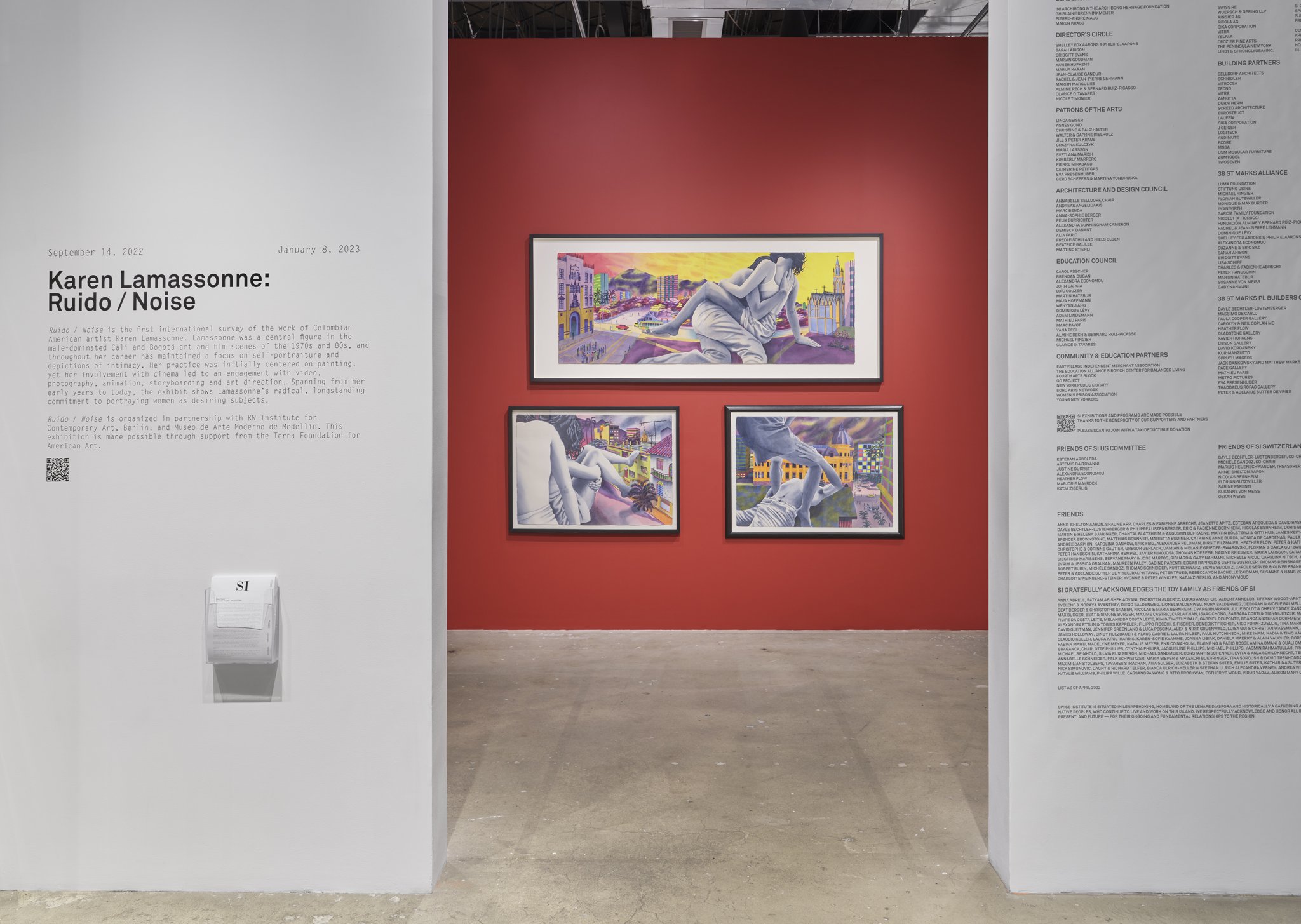
Karen Lamassonne: Ruido / Noise, installation view
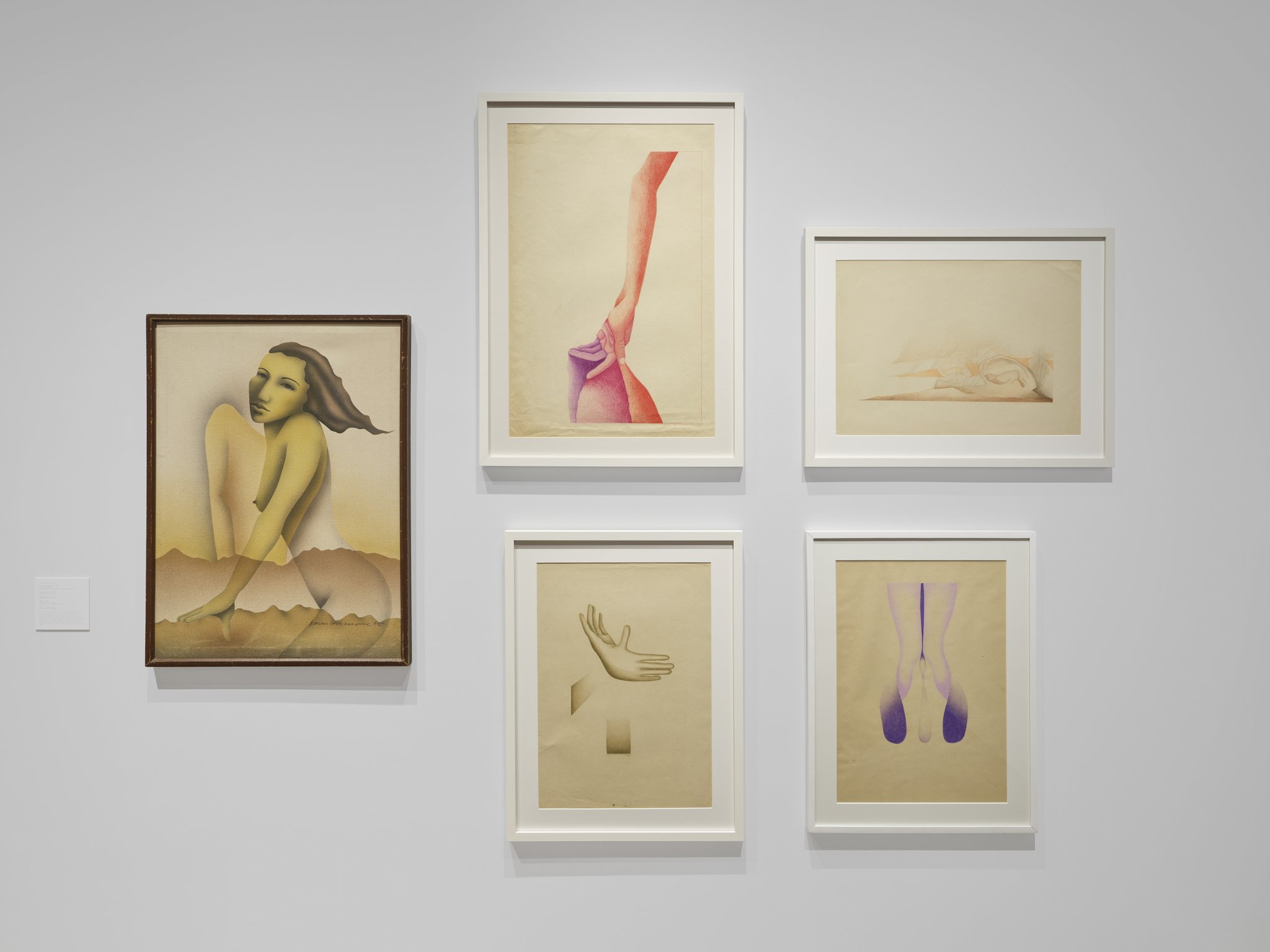
(clockwise from left)
Paisaje (Landscape), 1975. Airbrush on canvas. Courtesy Adriana Galimberti and Bernardo Olarte.
Sendero (Path), 1974 Colored pencil on paper.
Conchas (Ears), 1974. Colored pencil on paper.
Leggy, 1974. Colored pencil on paper. Courtesy Andrés Matute Echeverri.
Vuelo (Flight), 1974. Colored pencil on paper.
Lamassonne’s early pencil drawings and
airbrush paintings include subjects and
motifs that she would continue to pursue
throughout her career.
Paisaje (Landscape),
from 1975, is one of a series of airbrush
paintings by the artist that render figures
at the scale of landscapes. Other early
drawings include fragmented body parts that
take on attributes of organisms such as a
pair of hands in the form of a bird as seen
in
Vuelo (Flight), 1974, or ears that appear
to grow like crops from the soil in
Conchas
(Ears), 1974.
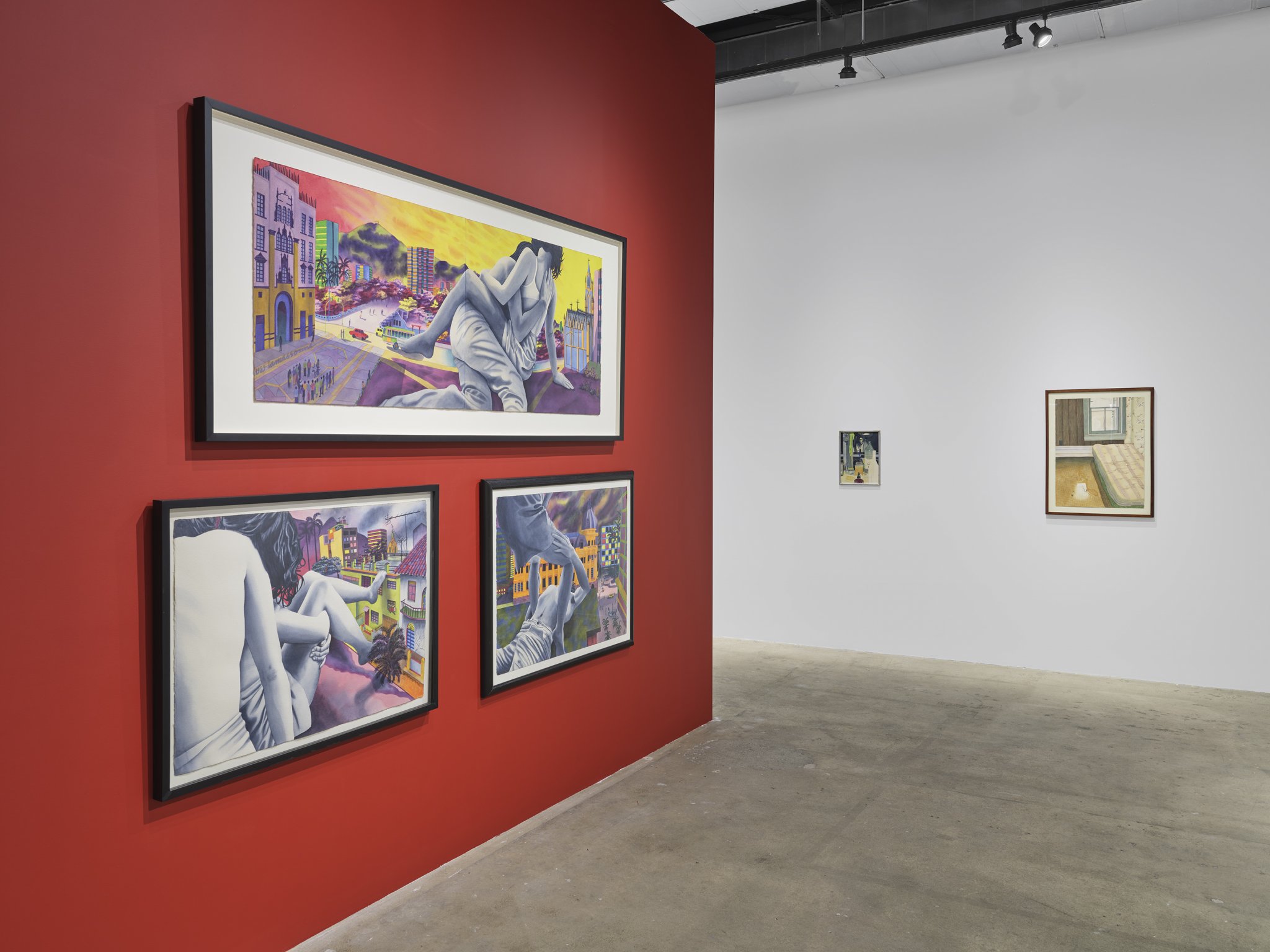
Karen Lamassonne: Ruido / Noise, installation view
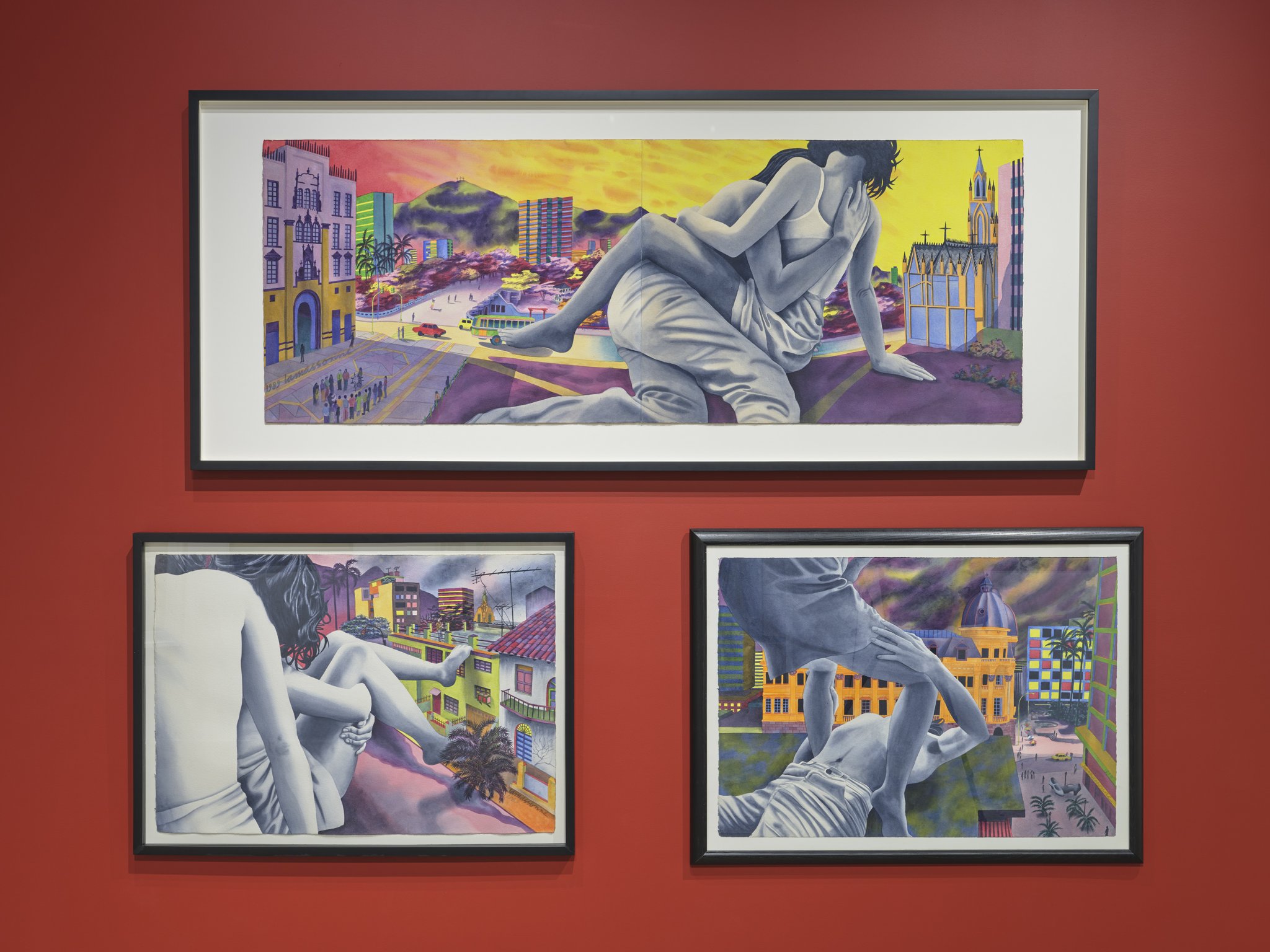
(clockwise from top)
Los Alférez Real (The Alférez Real), 1989. Acrylic on paper. Courtesy Andrés Matute Echeverri and Ignacio Goñi.
Sobre Isaacs (Above Isaacs), 1989. Acrylic on paper. Courtesy the Rick Gell.
Ventana Indiscreta (Rear Window), 1989. Acrylic on paper. Courtesy the artist and Instituto de Vision.
Lamassonne’s
Homenaje a Cali (Homage to Cali) series of paintings from 1989 features giant lovers dominating the lurid city skyline in scenes reminiscent of
Attack of the 50-Foot Woman (dir. 1958 Nathan Juran). This well-known pop cultural association, as well as the palette and the scale, demonstrate the influence that working in film was having on the artist at the time whilst also recalling early works in which bodies were drawn into landscapes.
Cali is Colombia’s third largest city, and
when Lamassonne arrived in the mid 1970s it
had recently undergone a vast urbanization
project to host the Pan American games in
1971. As Inti Guerrero has written, the city
“had a new urban tissue that enabled
anonymity,” creating “new places to fondle
and date, and new dynamics of courtship and
cruising.” Though by 1989 cartel violence
had begun to increase as a result of the US
“War on Drugs,” Lamassonne’s paintings are a
celebration of the city’s sensual life, even
in the face of risk.
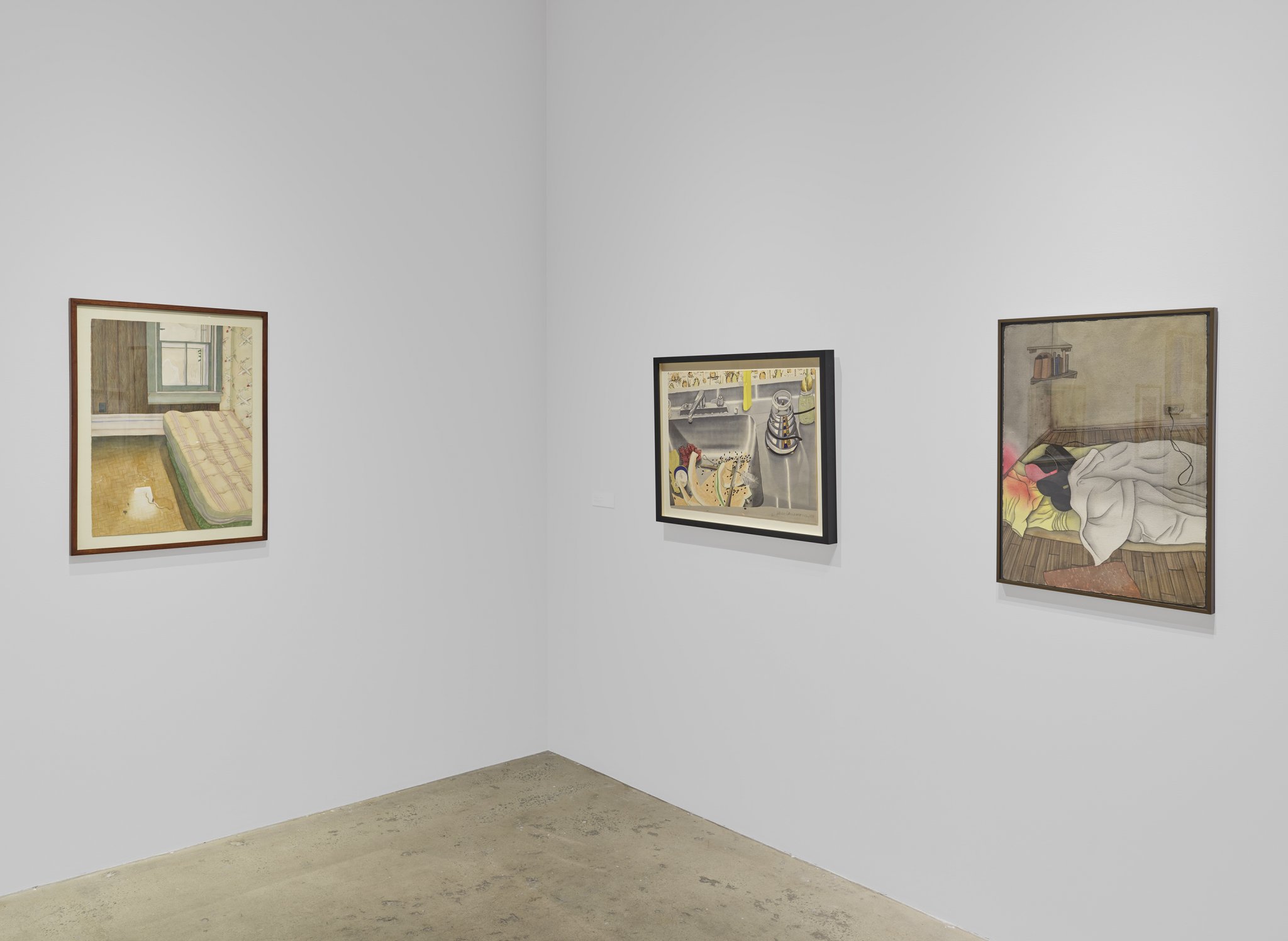
Karen Lamassonne: Ruido / Noise, installation view
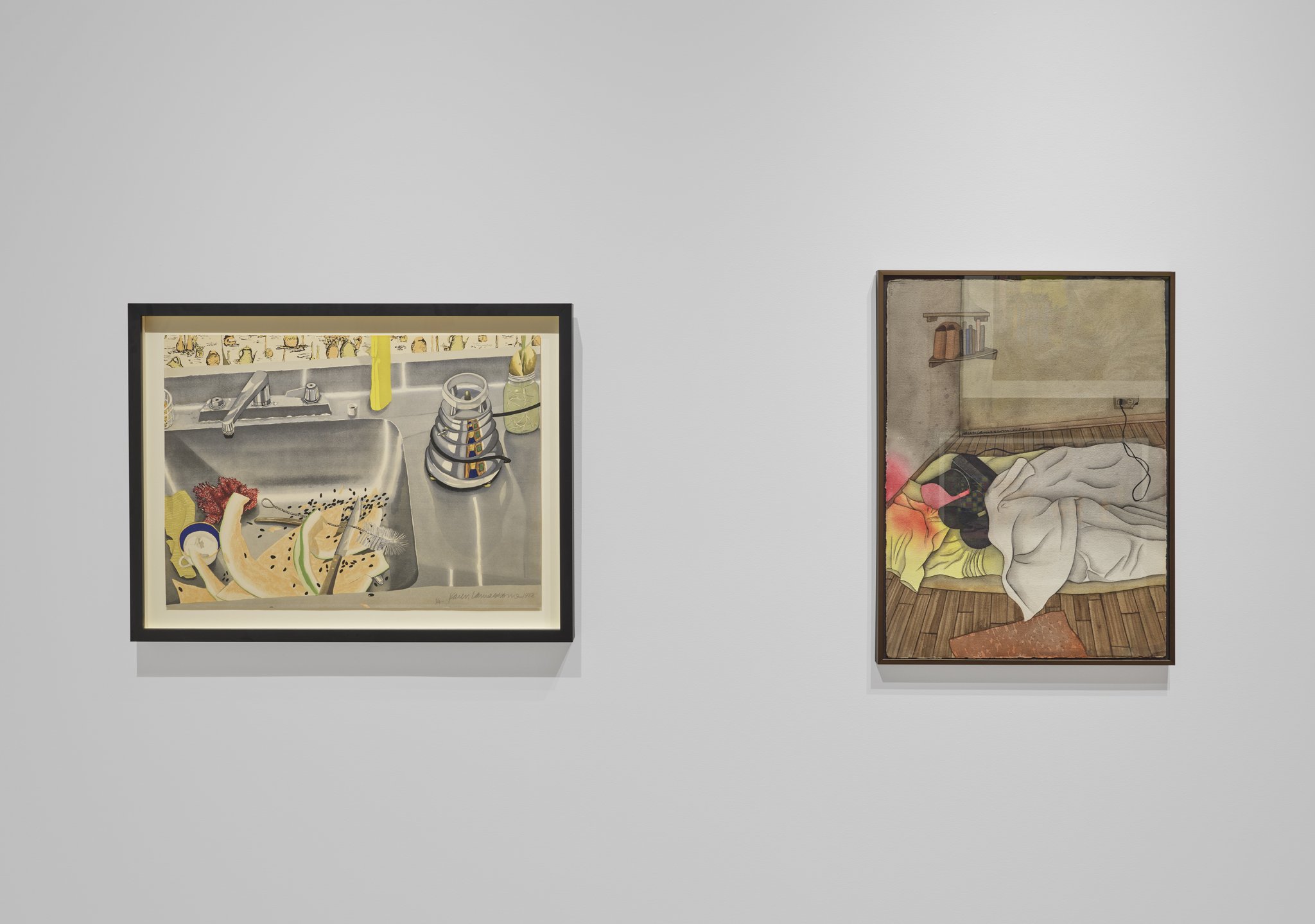
(from left to right) Las Pepitas (The Pits), 1988. Silk-screen print. Semáforo en rojo (Red Light), 1976. Watercolor on paper. Courtesy Radha Hernandez.
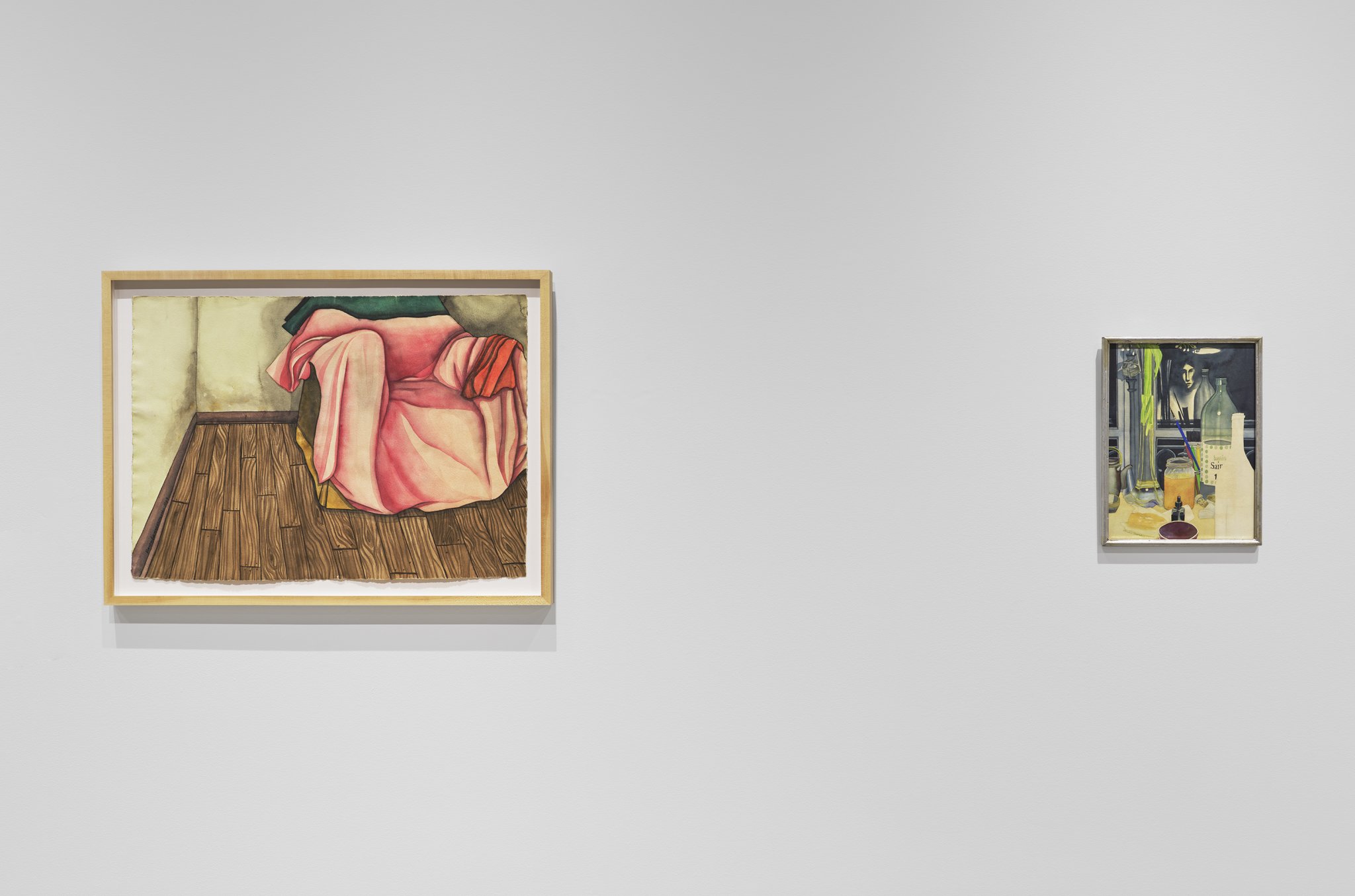
(from left to right) La Poltrona (Easy Chair), 1977. Watercolor on paper. Auto reflection (Self-Portrait), 1978. Watercolor on paper.
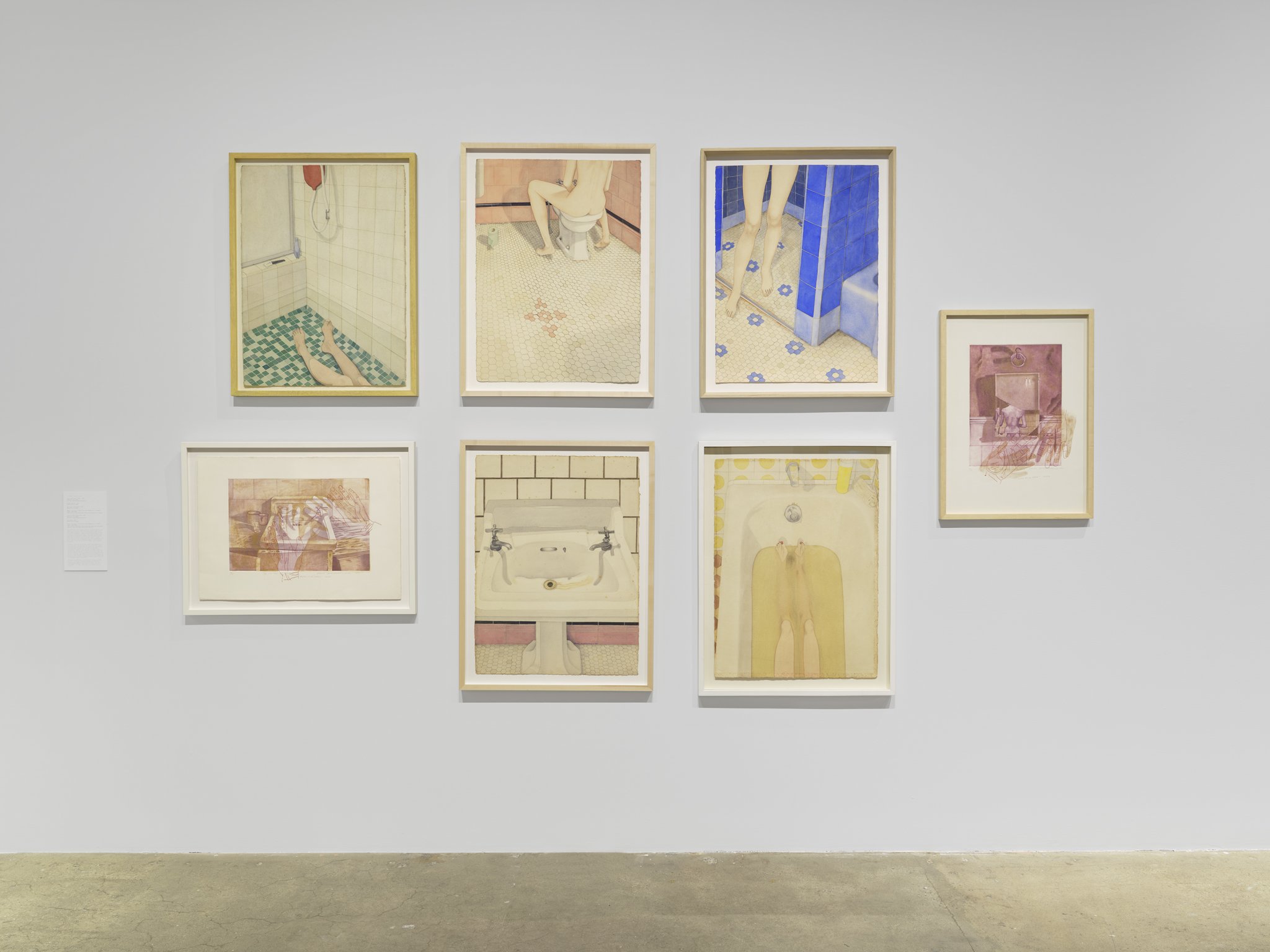
Karen Lamassonne:
Ruido / Noise, installation view
The
Baños watercolor series (1978-81) are paintings of lone women in decoratively tiled bathrooms, mostly naked or in some state of undress. Many of the paintings have a serene or restful atmosphere, suggesting that the bathroom is here acting as a “room of one’s own” – the space Virginia Woolf described as requisite for women to be able write fiction. Lamassonne has tended to describe the figures in these paintings as herself, though they are usually anonymized by being seen only from the shoulders down or from the back. The figure is posed on toilets and bidets, and in showers and baths.
A number of these paintings were shown in an exhibition at the Galería del Club de Ejecutivos in Cali in 1979, which was prematurely shut down because some of the “executives” – men who used the space for lectures and meetings – felt unable to conduct their business in view of such “obscenities.” While it remains unclear precisely what the source of the outrage was, it seems likely that it was the matter-of-factness of a body pictured with bathroom fixtures that was troubling. The implied associations with bodies as dirty or clean, between excretions and ablutions, meant that the paintings described a boundary that was quickly policed in the name of female propriety.
Lamassonne created many self-portraits in domestic spaces and still lives that included references to the home including ovens, bedrooms and cluttered sinks. The artist often pictures herself subjectively in relation to their environment, as though these spaces are an extension of herself.
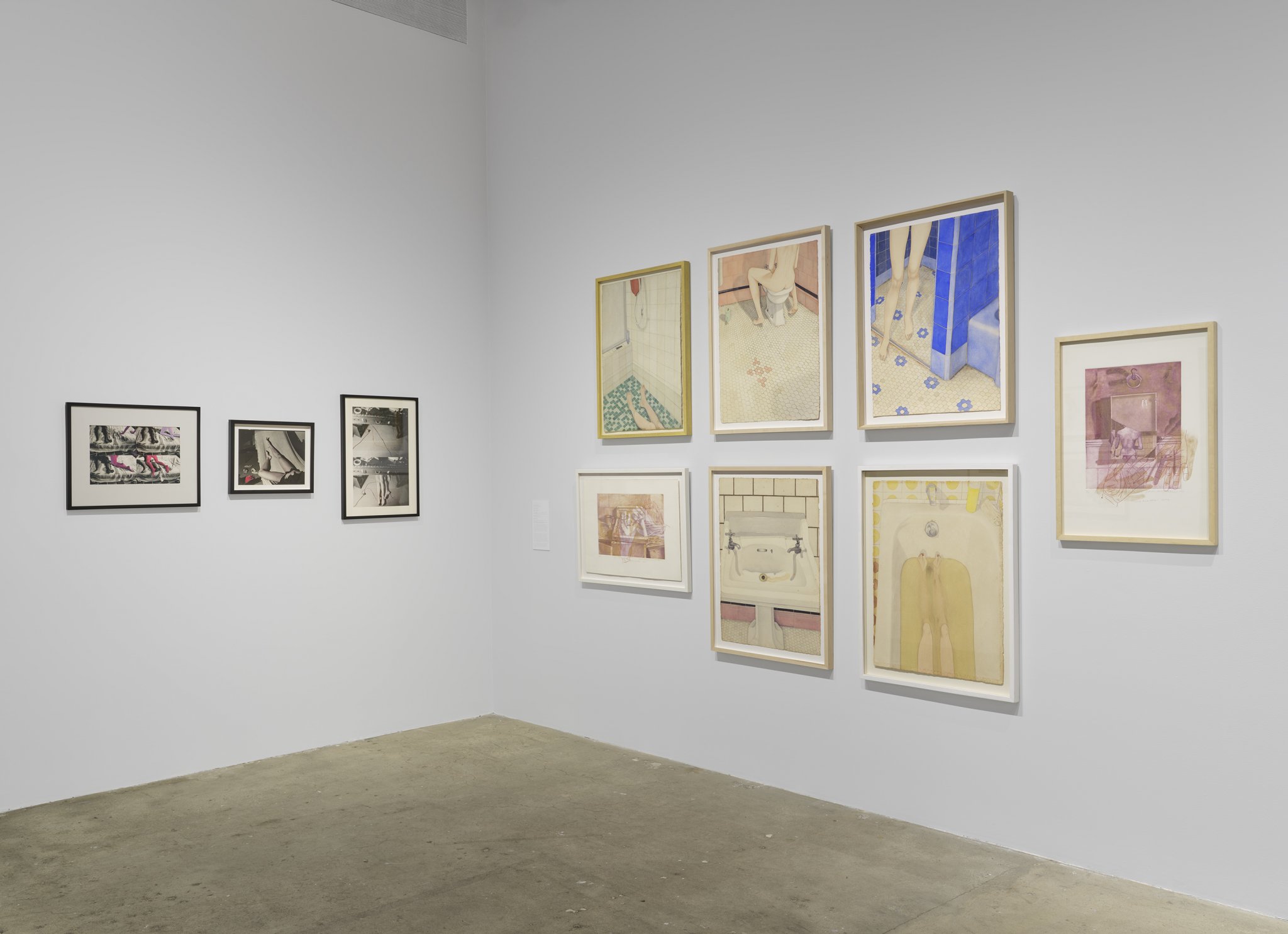
Karen Lamassonne: Ruido / Noise, installation view
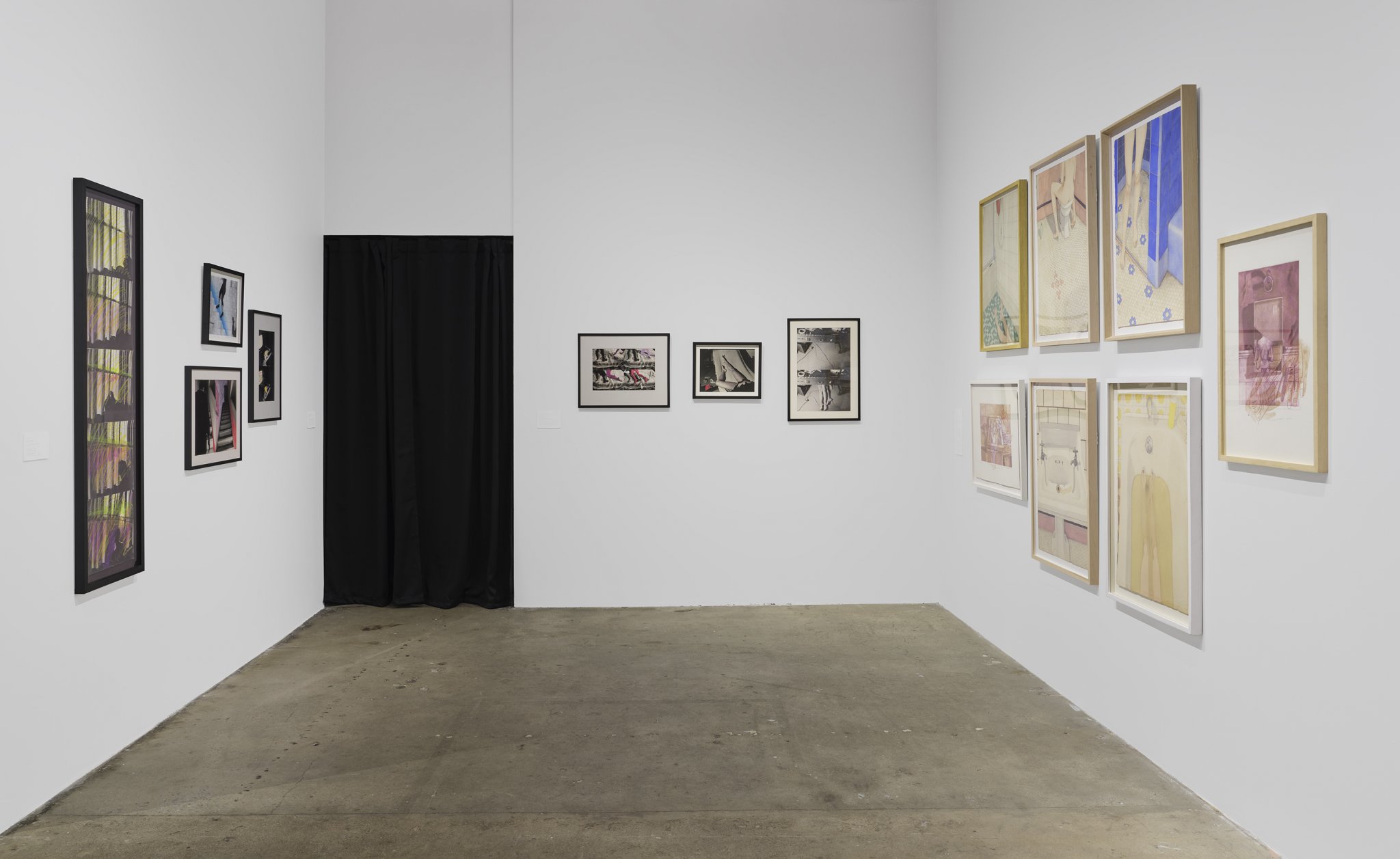
Karen Lamassonne: Ruido / Noise, installation view
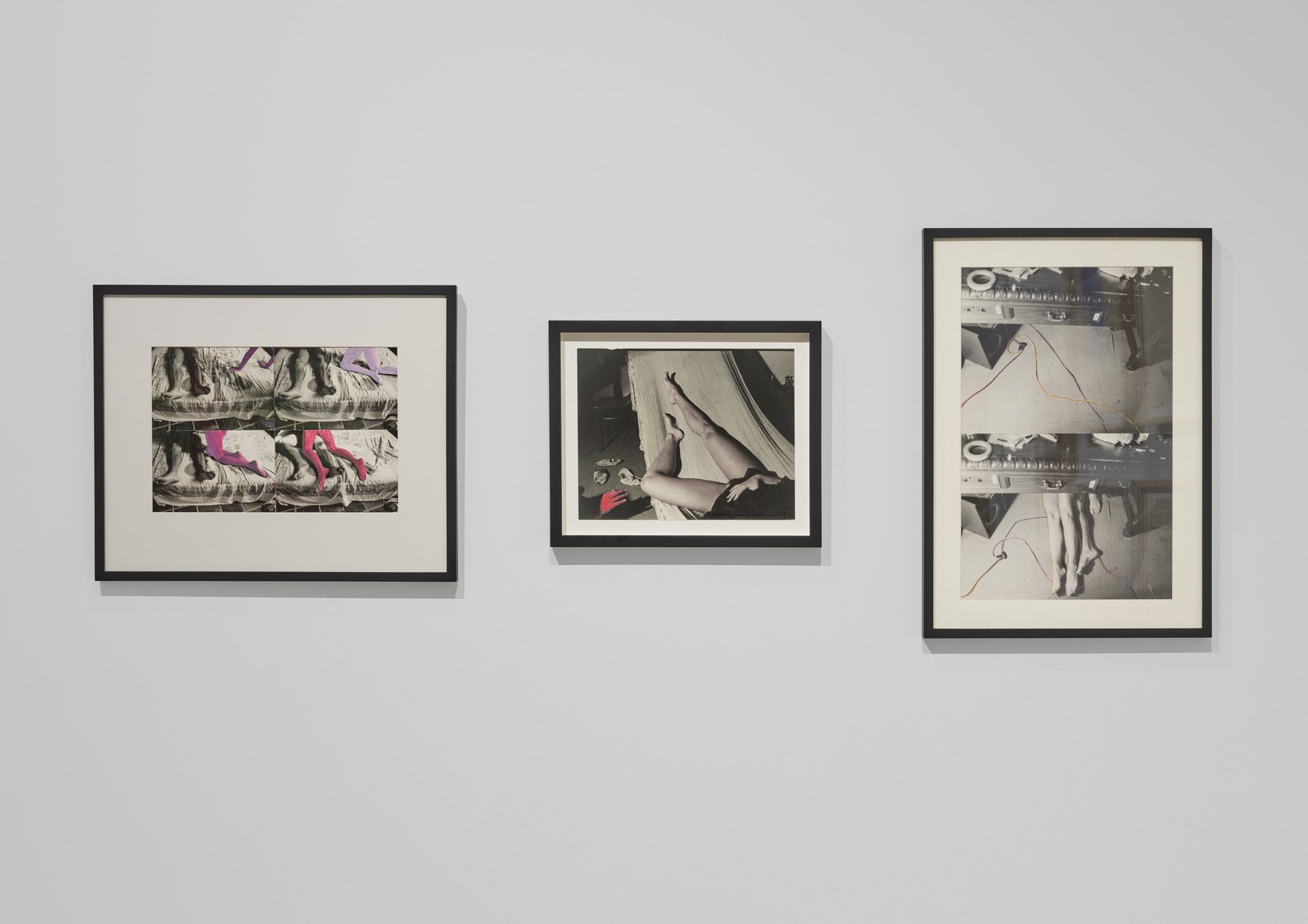
(from left to right)
Sueño húmedo (Wet Dream), 1987. Photo with crayon.
Sueño húmedo I (Wet Dream I), 1987. Photo with crayon.
Sueño Humedo VI (Wet Dream VI), 1987. Photo with crayon. Courtesy the artist and Instituto de Vision.
Following her experience in cinema,
Lamassonne began taking photographic series
with narrative sequences, following
unidentified bodies in playful, sensual or
ambivalent scenarios. In the series
Sueños
Húmedos (Wet Dreams), Lamassonne highlights
elements of the images in colorful crayon,
suggesting heat or energy that is emerging.
As in many of her earlier paintings, legs
stand in for entire bodies, entangled with
others or laid on the floor.
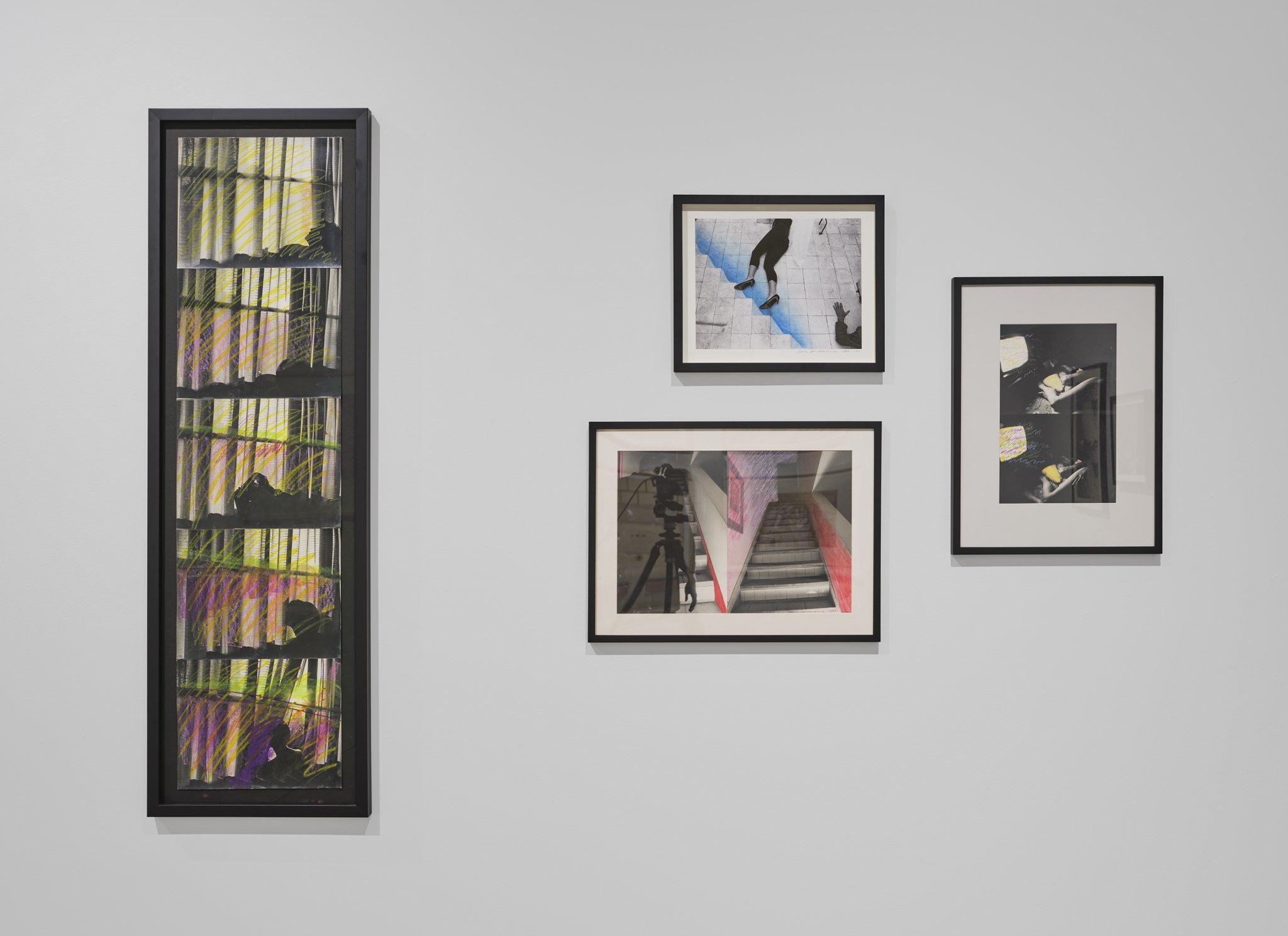
(clockwise from left) Amanecida (Dawning), 1985. Photo with crayon. Sueno húmedo III (Wet Dream III), 1987. Photo with crayon. TV Ruido (TV Noise), 1987. Photo with crayon. Courtesy Jose Dario Gutierrez. Sueno húmedo II (Wet Dream II), 1987. Photo with crayon. Courtesy the artist and Instituto de Vision.
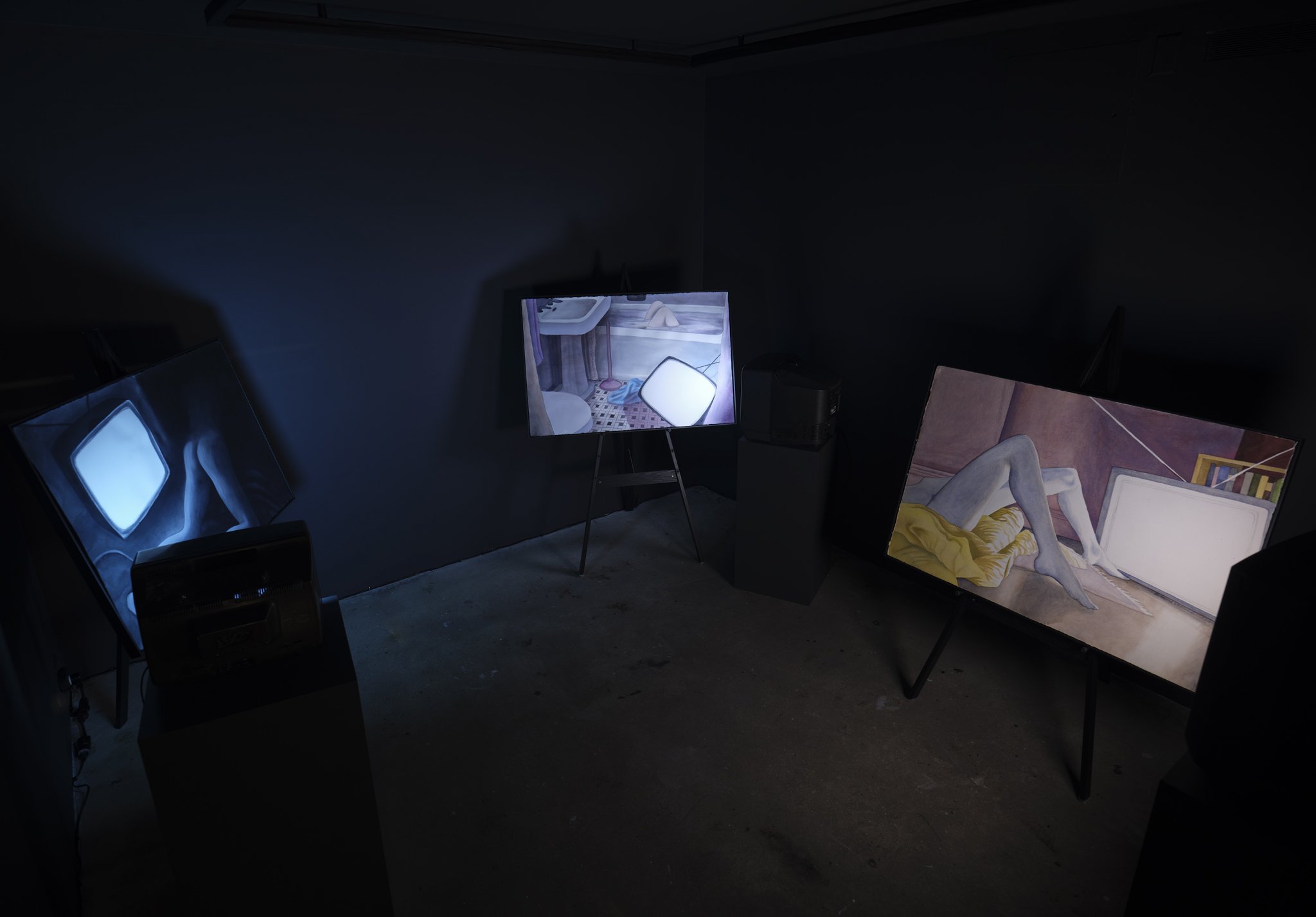
Ruido (Noise), 1984-2021. Paintings: Acrylic on paper. Video: ½ inch VHS video converted to digital, color and sound. 12 min 40 sec.
This is the first realization of an
installation that Lamassonne proposed in
1984 entitled
Ruido (Noise). It features an
experimental video of the same name made by
Lamassonne while the artist lived in New
York City one winter. The video contrasts
the heat of a lone, naked body pitched
against other environments and temperatures,
including the freezing city snow. The glow
of the television playing this video and
others, which play static snow, are the only
lights in this darkened space, illuminating
and animating the paintings installed around
them, each depicting a woman’s body
illuminated by the glow of a TV.
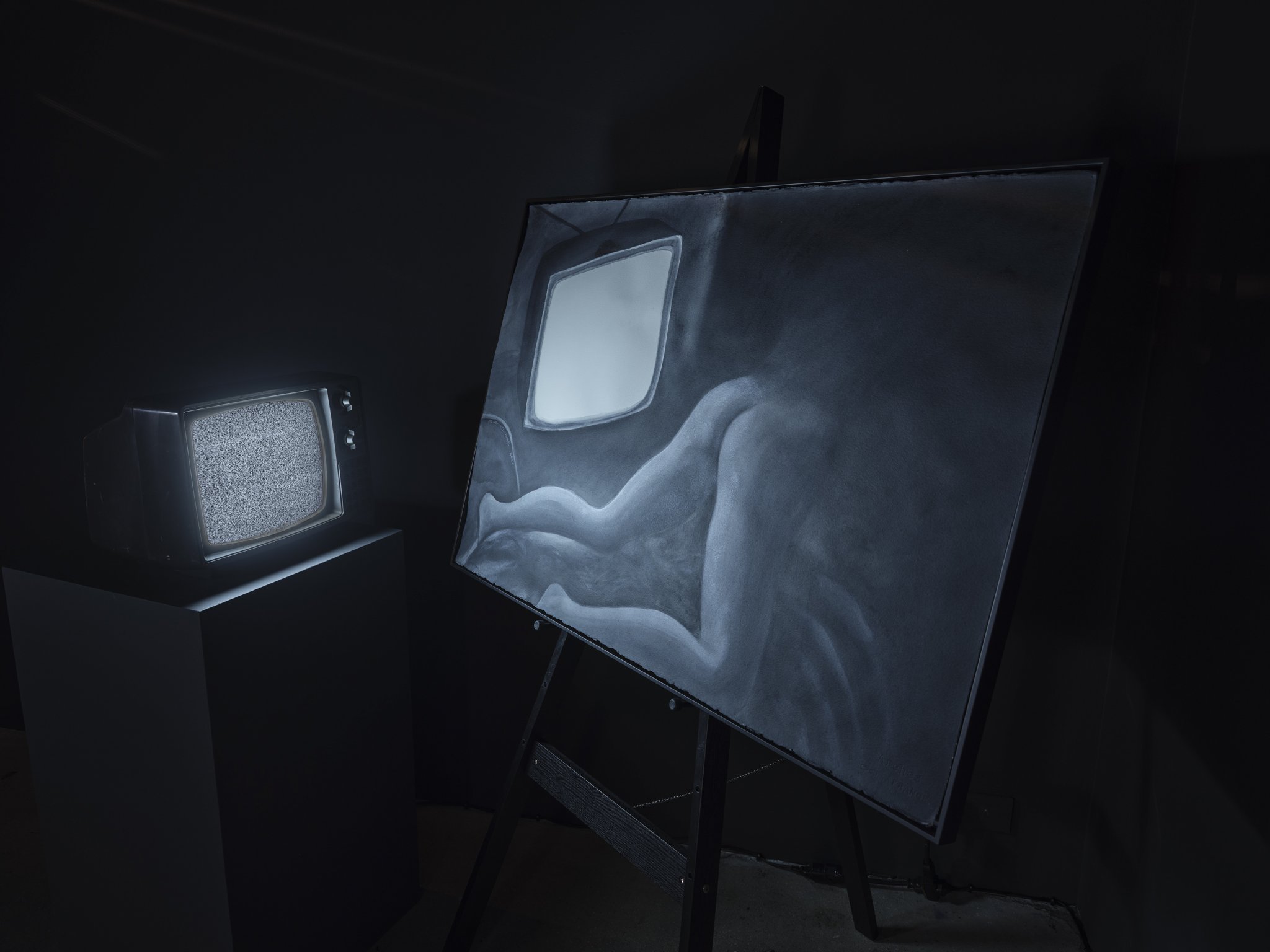
Ruido (Noise), 1984-2021, installation detail
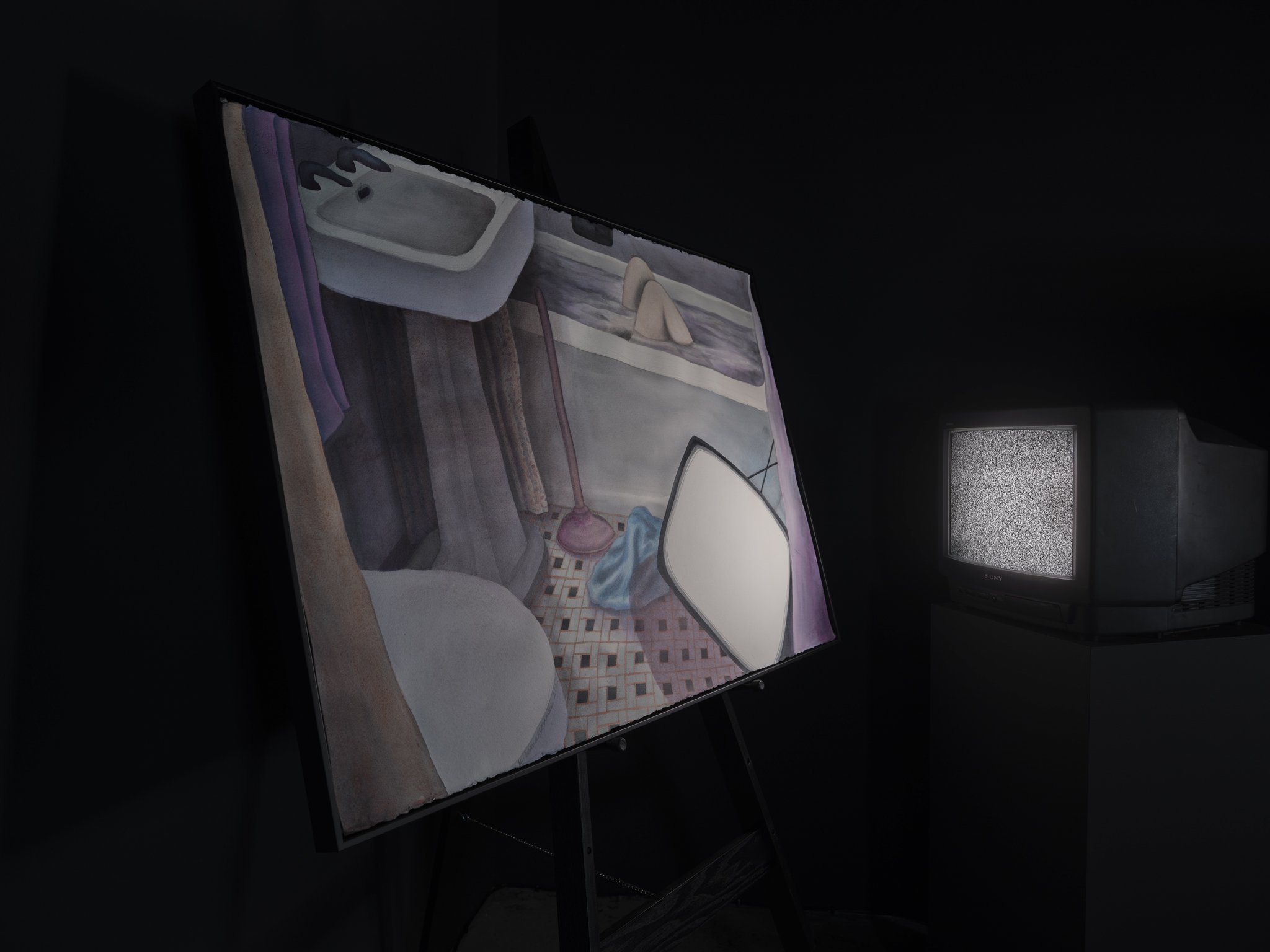
Ruido (Noise), 1984-2021, installation detail
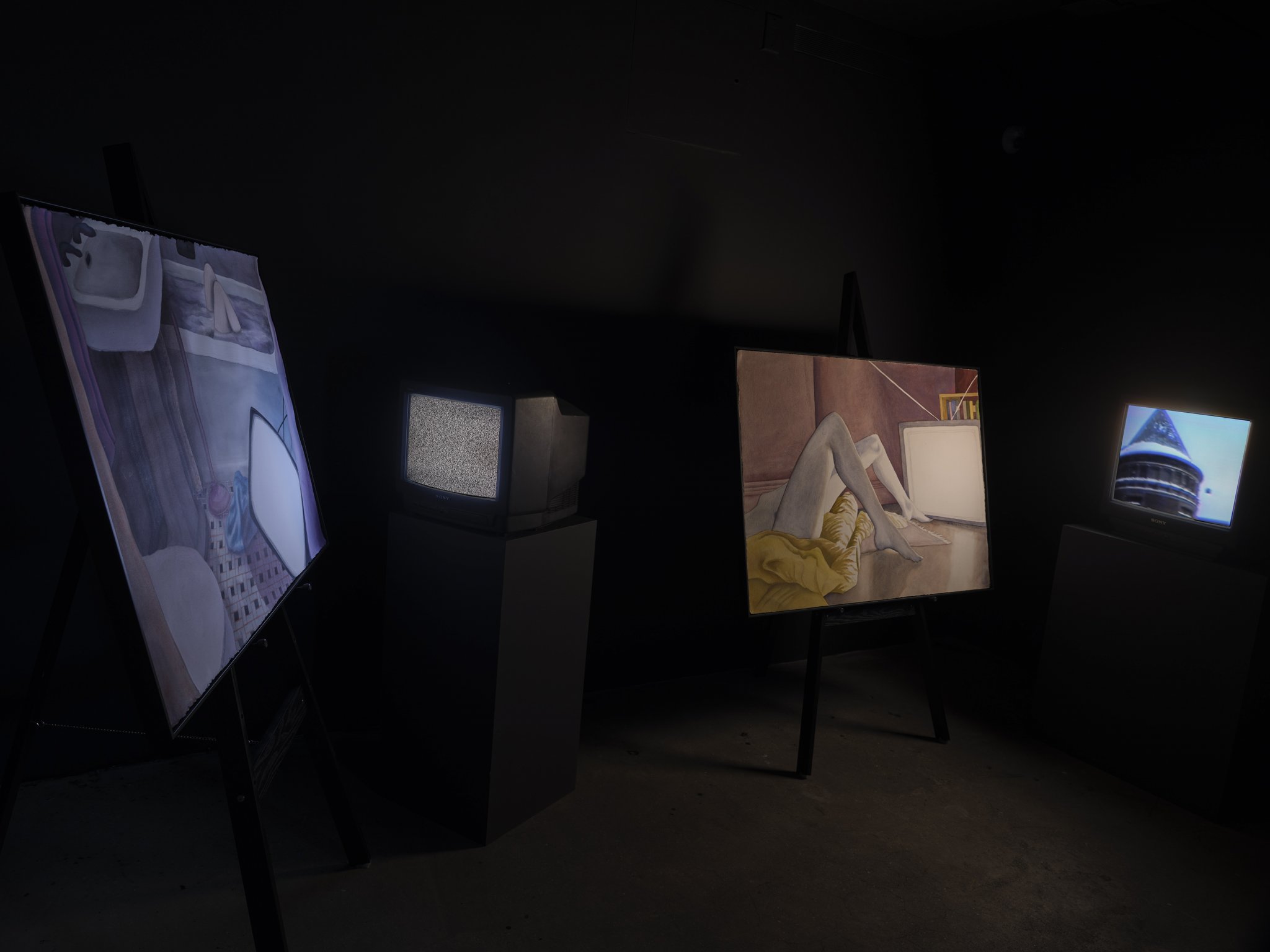
Ruido (Noise), 1984-2021, installation detail
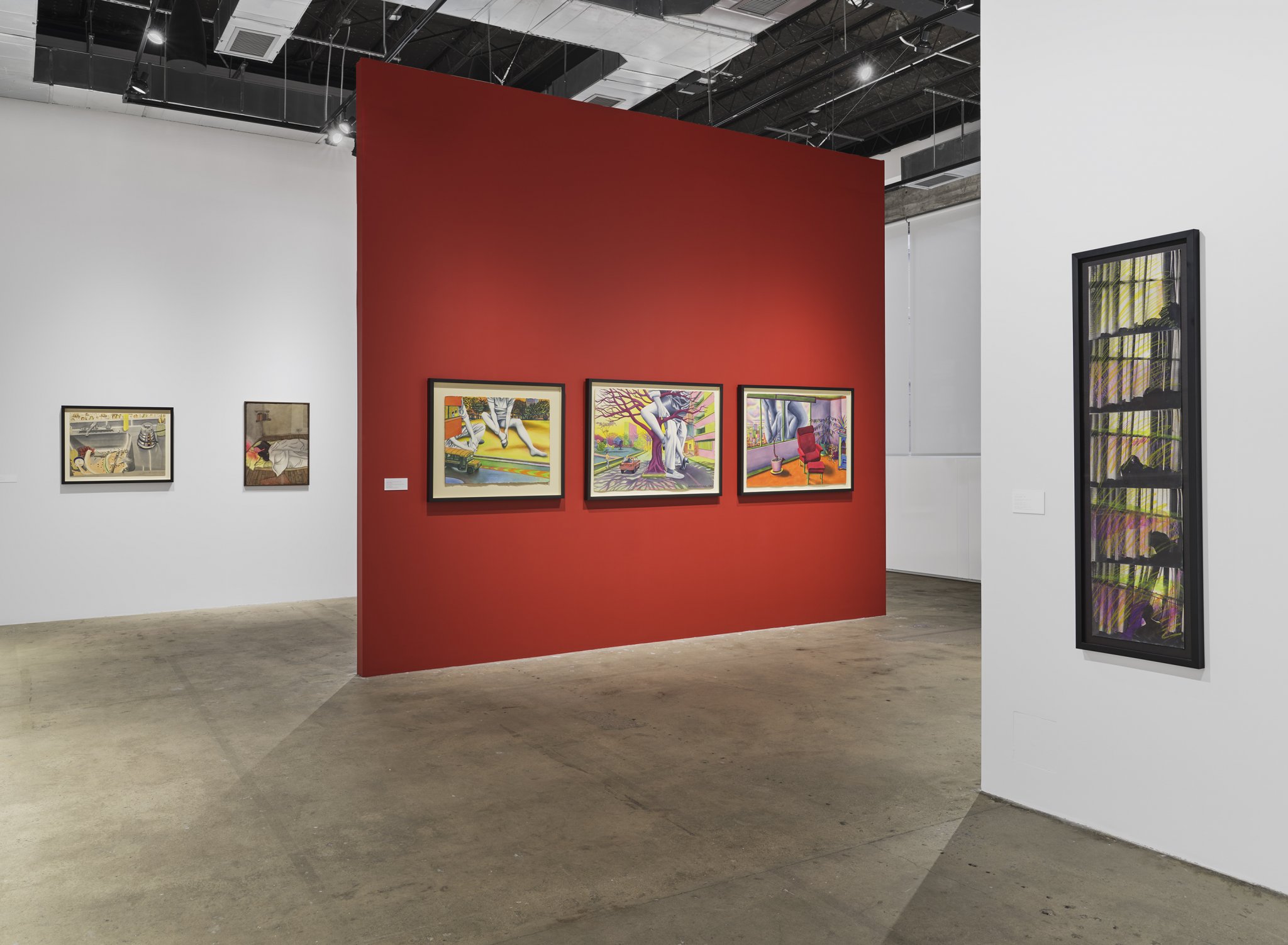
Karen Lamassonne: Ruido / Noise, installation view
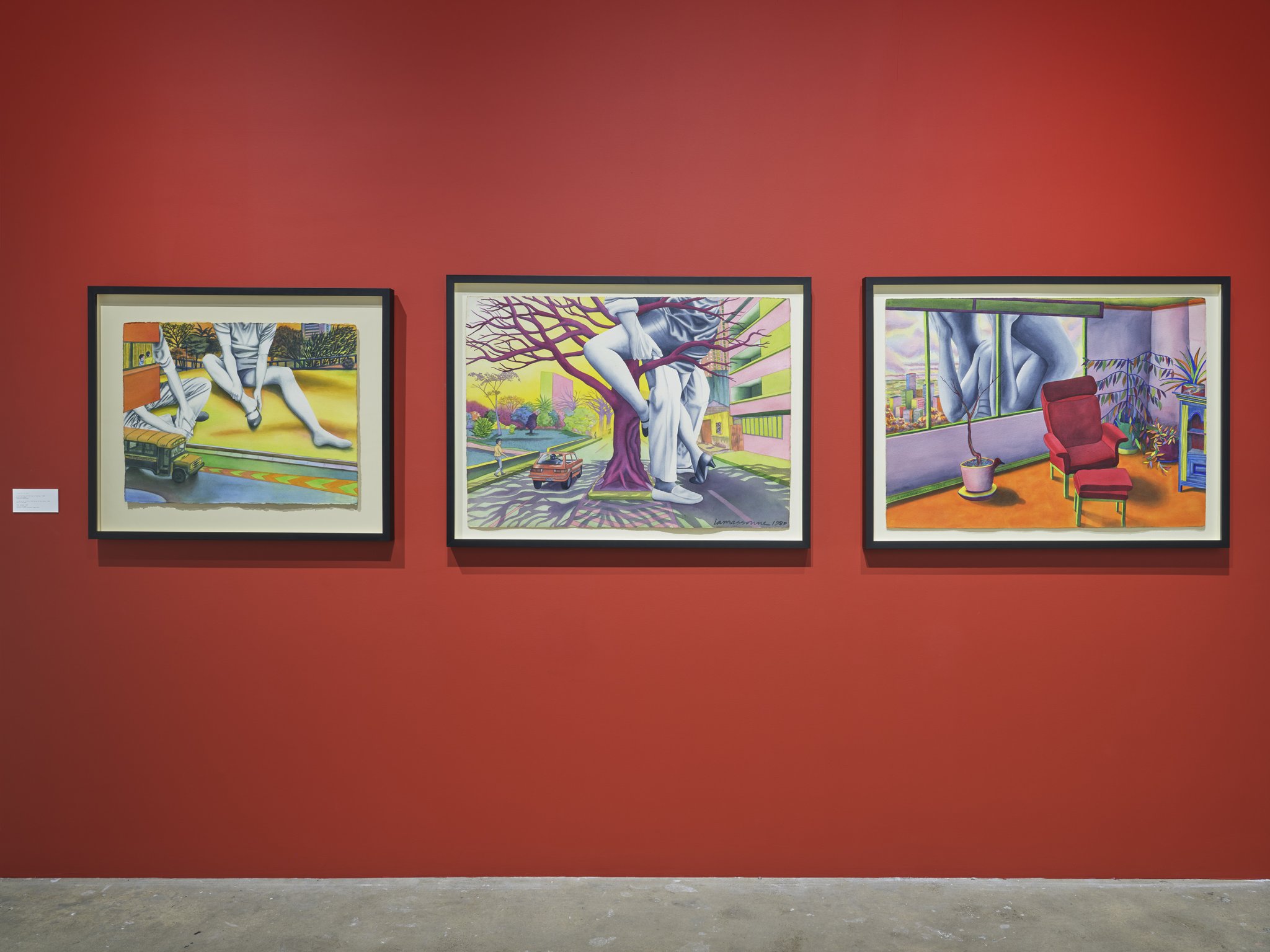
(from left to right) Al pie del Bus (At the Foot of the Bus), 1989. Acrylic on paper. Courtesy Lina Uribe. La Venida de la Ceiba (The Coming of the Ceiba), 1989. Acrylic on paper. Ruby Tuesday, 1989. Acrylic on paper. Courtesy Lorenzo González Lamassonne.
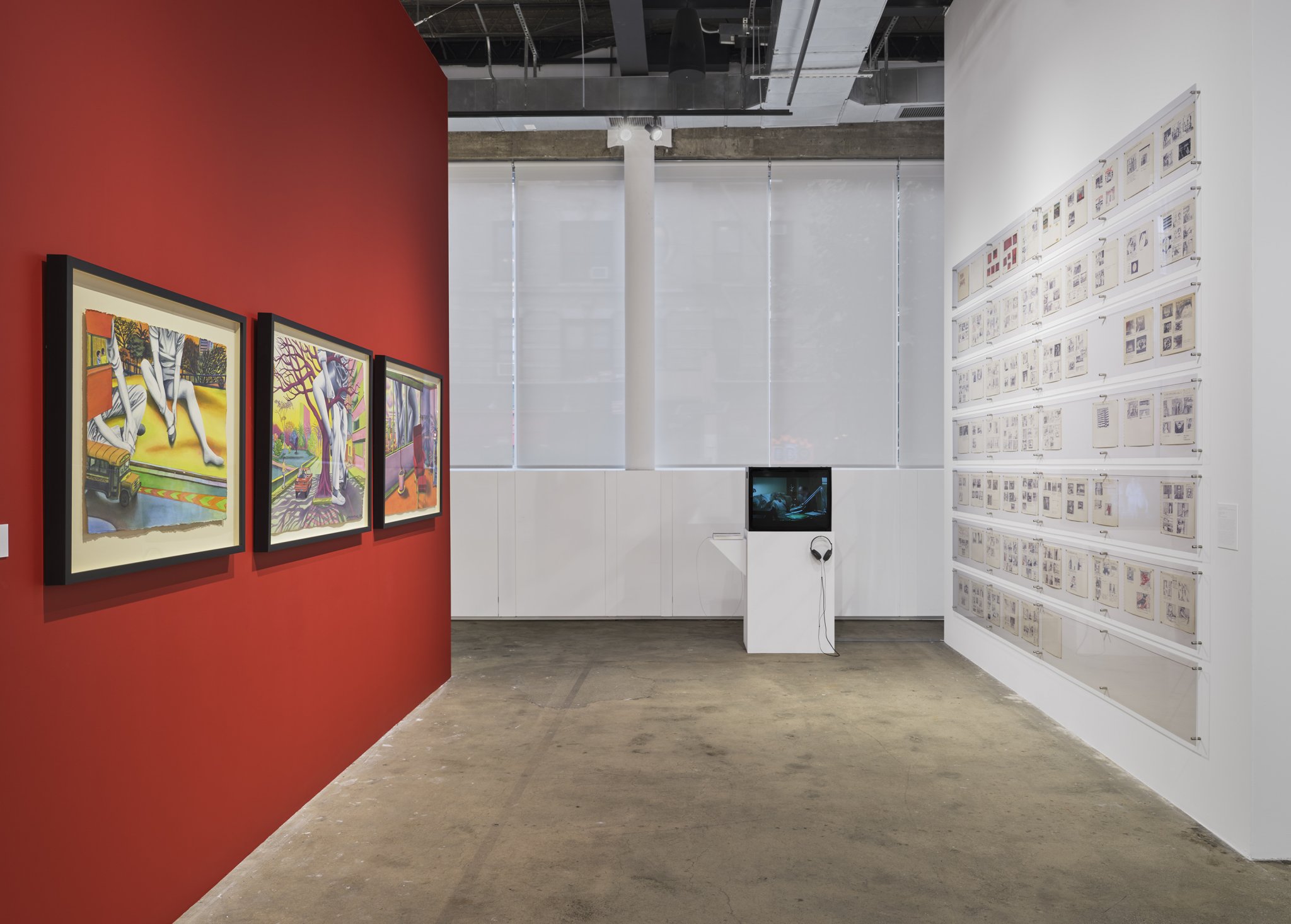
Karen Lamassonne: Ruido / Noise, installation view
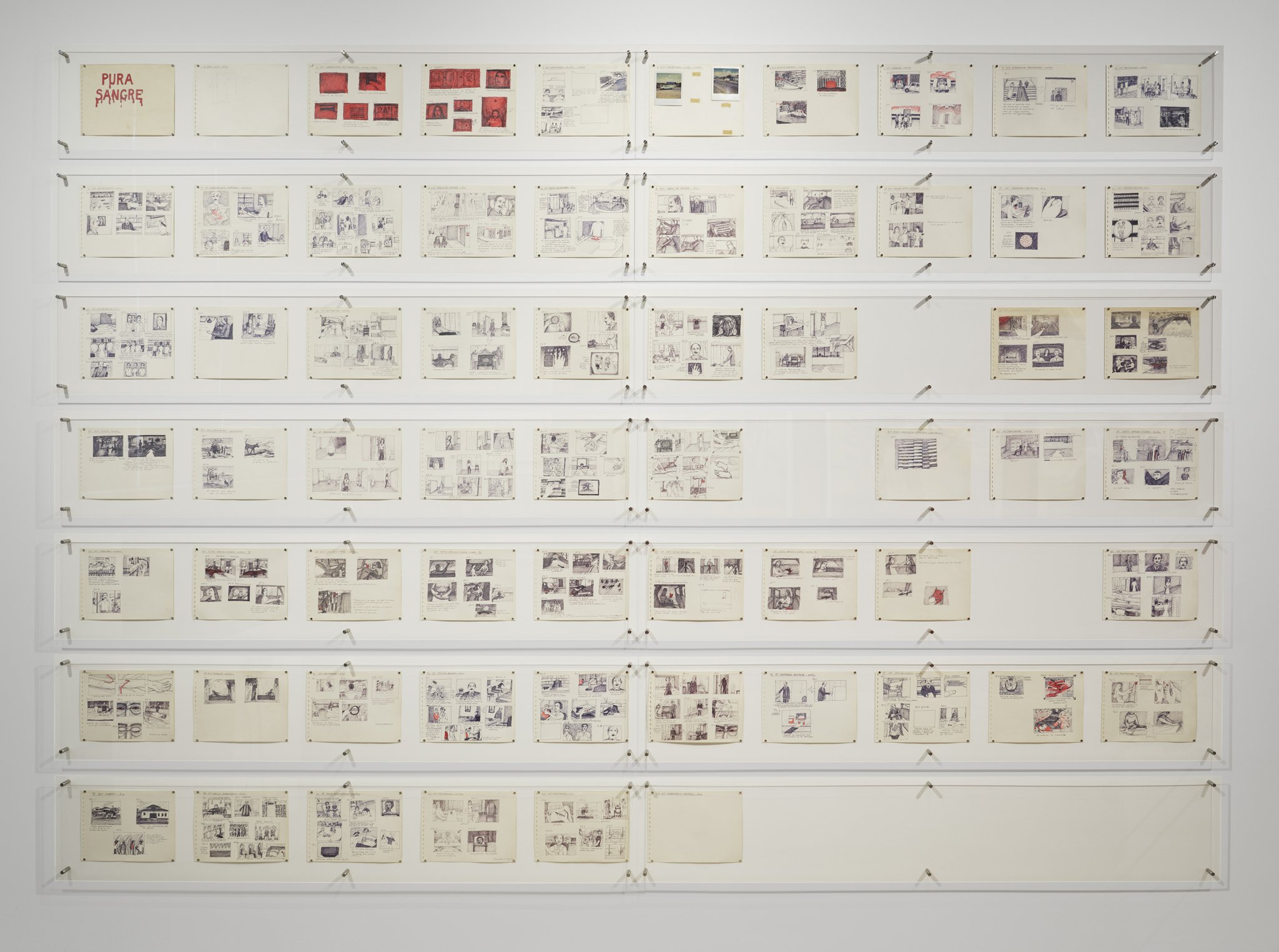
Pura Sangre (Pure Blood), 1982. Selection from 122 pages of ink on paper, storyboard of the feature film.
Cali was home to an energetic film scene in the 1970s, which gathered around clubs such as Cine Club de Cali, founded in 1969 by the writer Andrés Caicedo, a celebrated young novelist who later co-founded and directed the film journal Ojo al Cine (1974-76). Lamassonne was part of a network of filmmakers who became known as the Grupo de Cali (Cali group), most often associated with directors Luis Ospina and Carlos Mayolo, who made their first film together during the 1971 Pan American Games in Cali and worked together on films such as Agarrando Pueblo (The Vampires of Poverty), 1977. The group often employed popular B-movie genres such as horror or crime to create political allegories that also skewered mainstream Colombian cinema. Lamassonne worked closely with them on several films as an editor, art director and actor, including editing and acting on Carne de tu Carne (dir. Mayolo, 1983), and creating the storyboard and art direction for Pura Sangre (Pure Blood) (dir. Luis Ospina, 1982), on which she also worked as Assistant Director and Assistant Editor. Displayed here are selected scenes from Lamassonne’s storyboard for Pura Sangre, a horror thriller centering on a rich sugar magnate who survives on the fresh blood of murder victims.
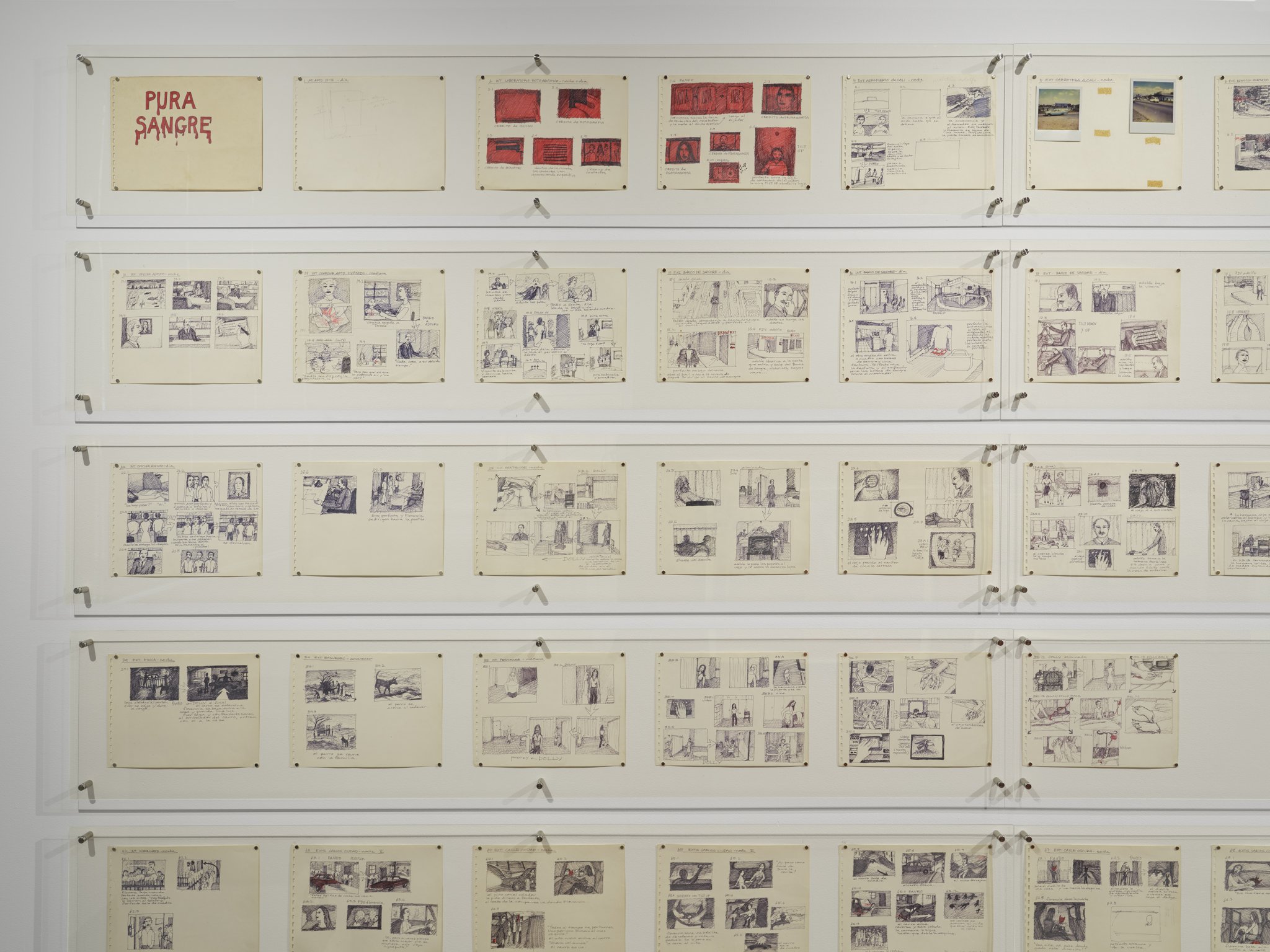
Pura Sangre (Pure Blood), 1982, storyboard detail
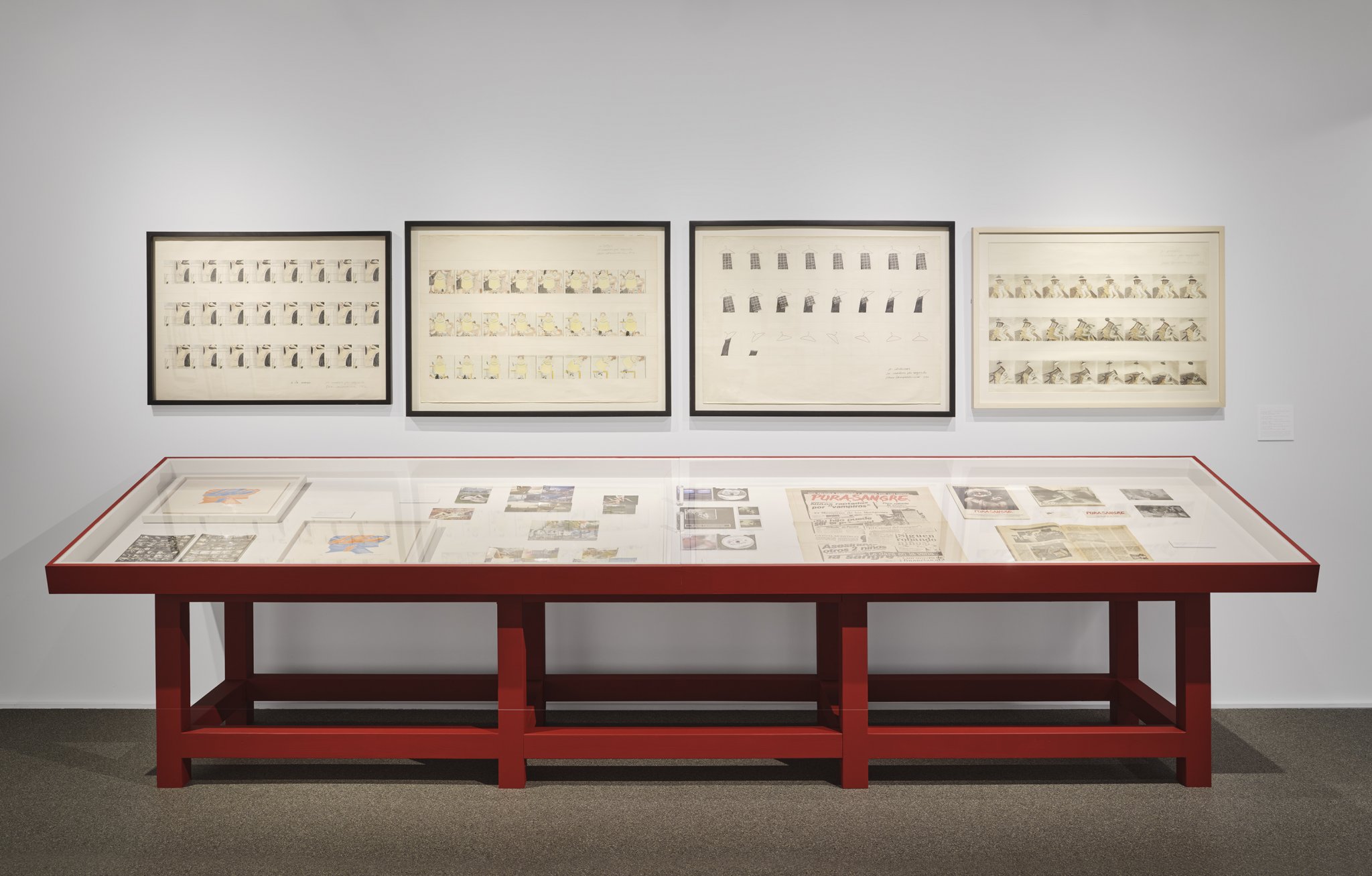
Karen Lamassonne: Ruido / Noise, installation view
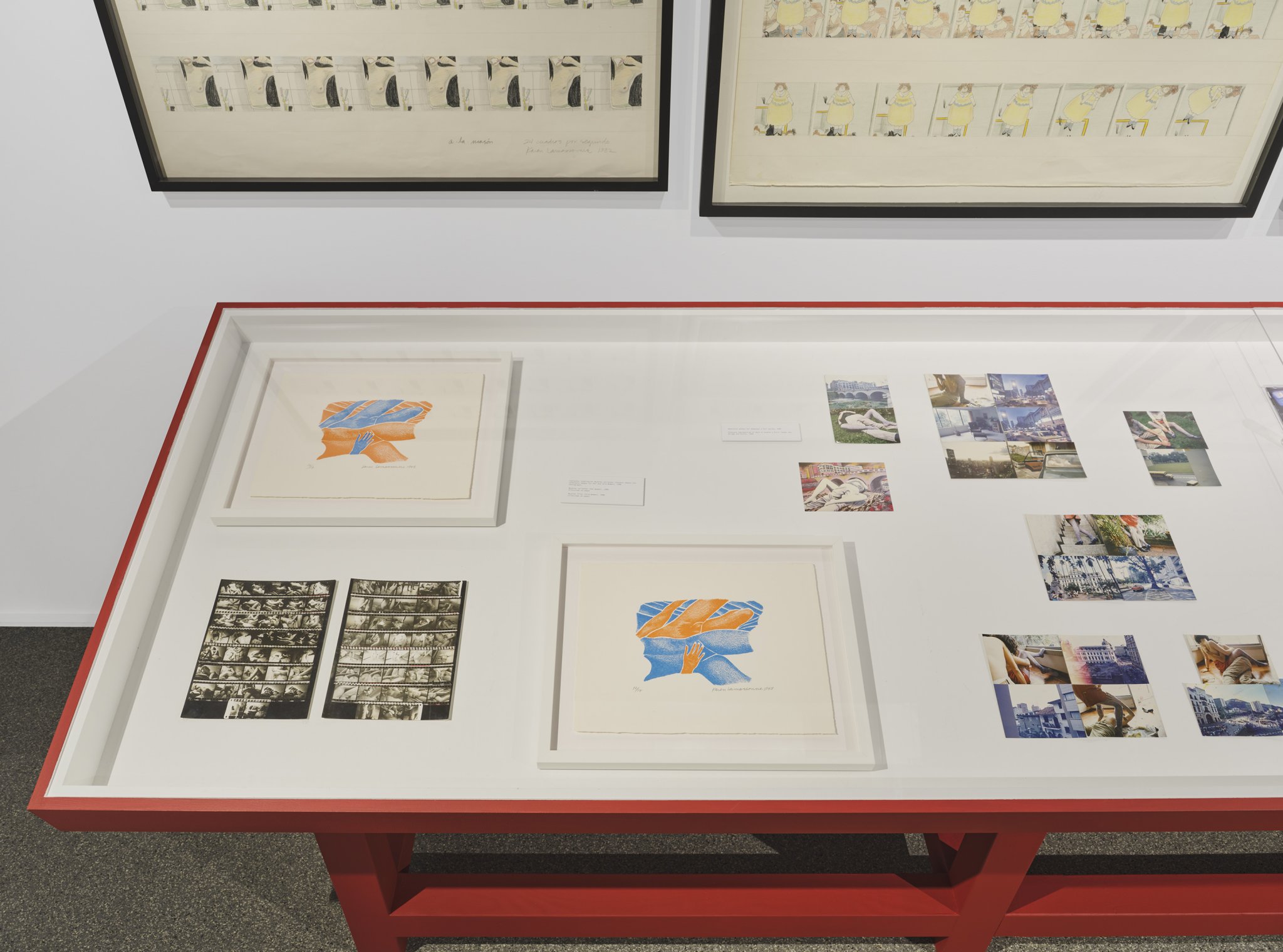
Karen Lamassonne: Ruido / Noise, installation view
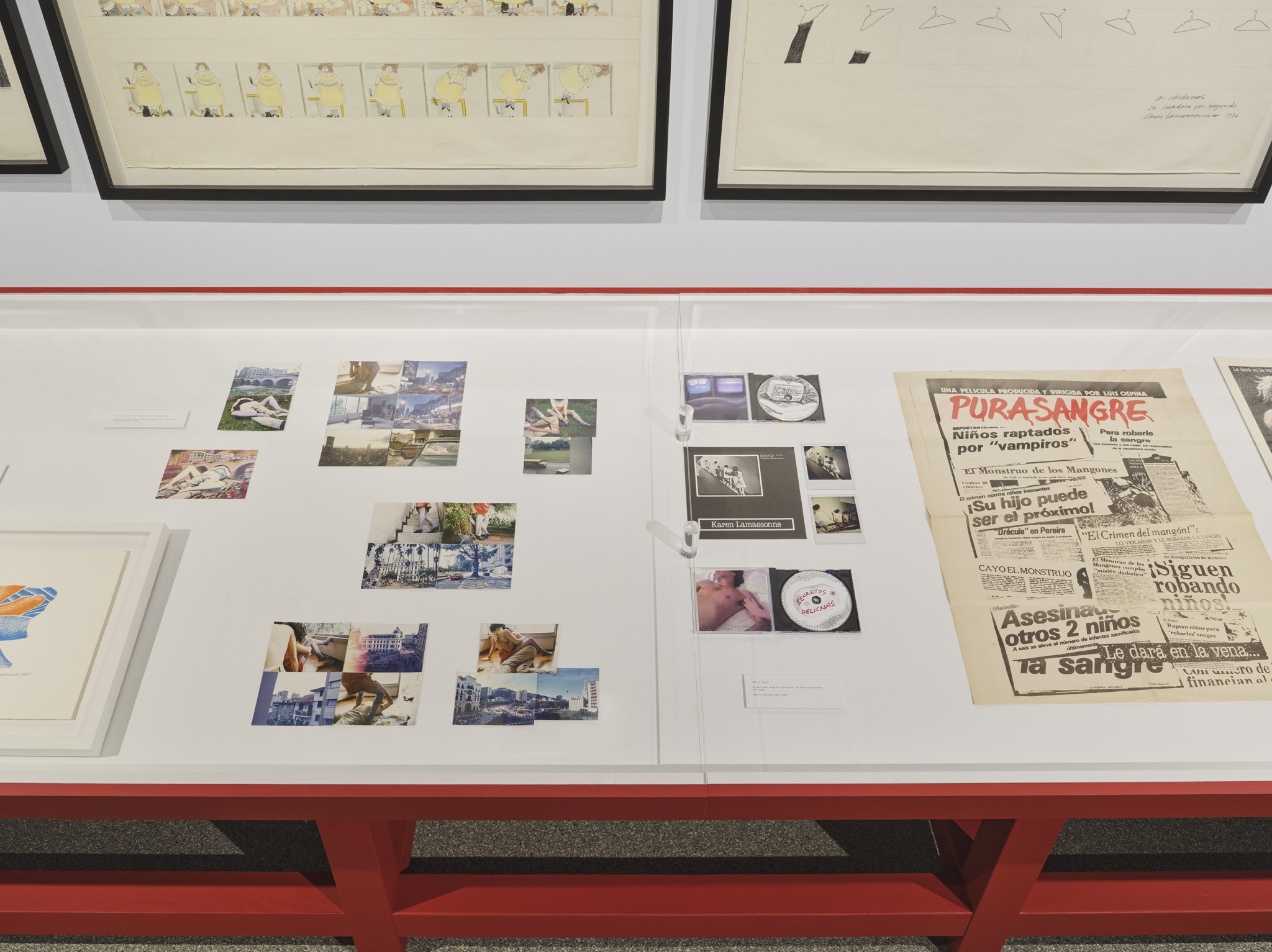
Karen Lamassonne: Ruido / Noise, installation view
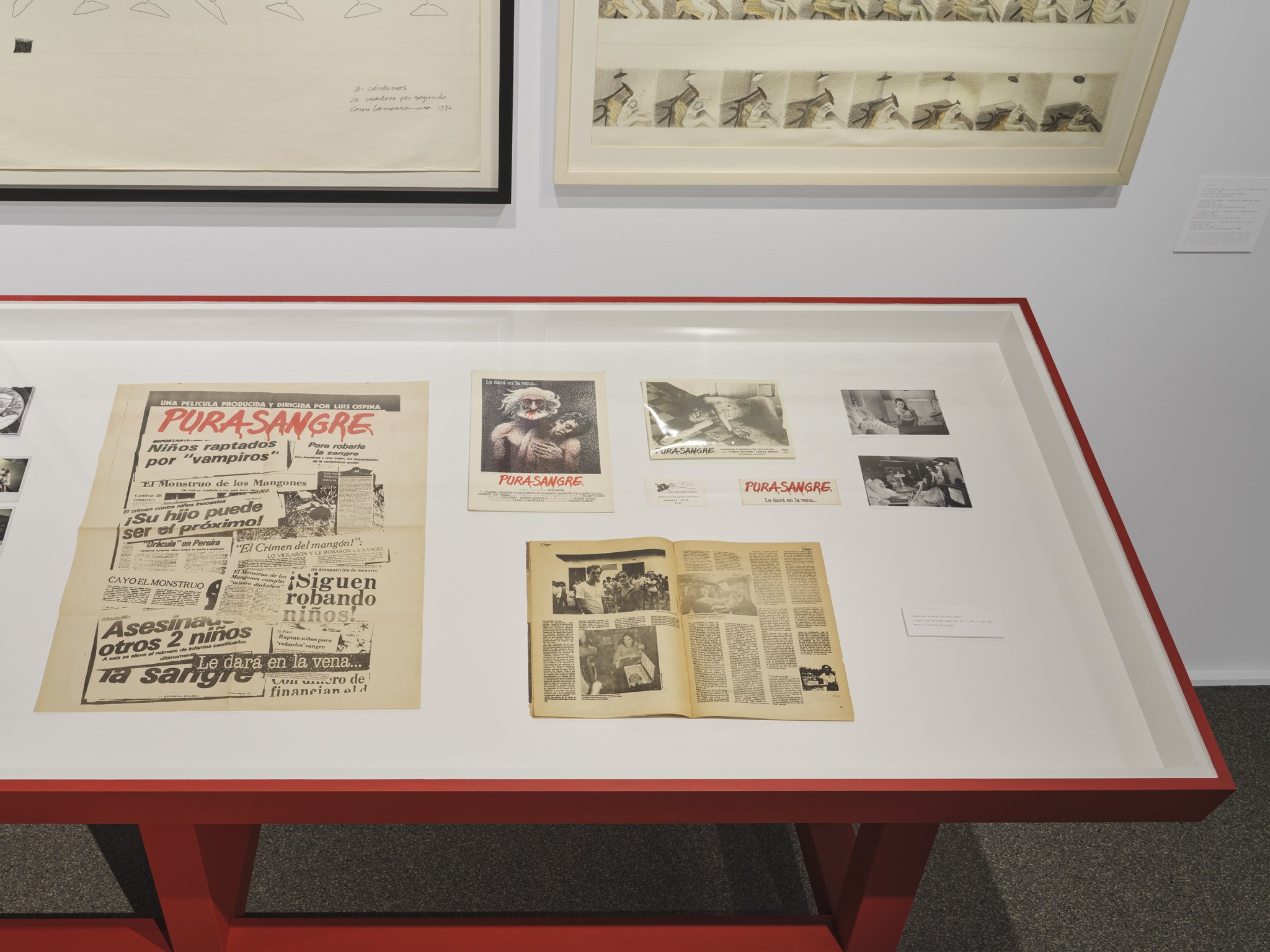
Karen Lamassonne: Ruido / Noise, installation view
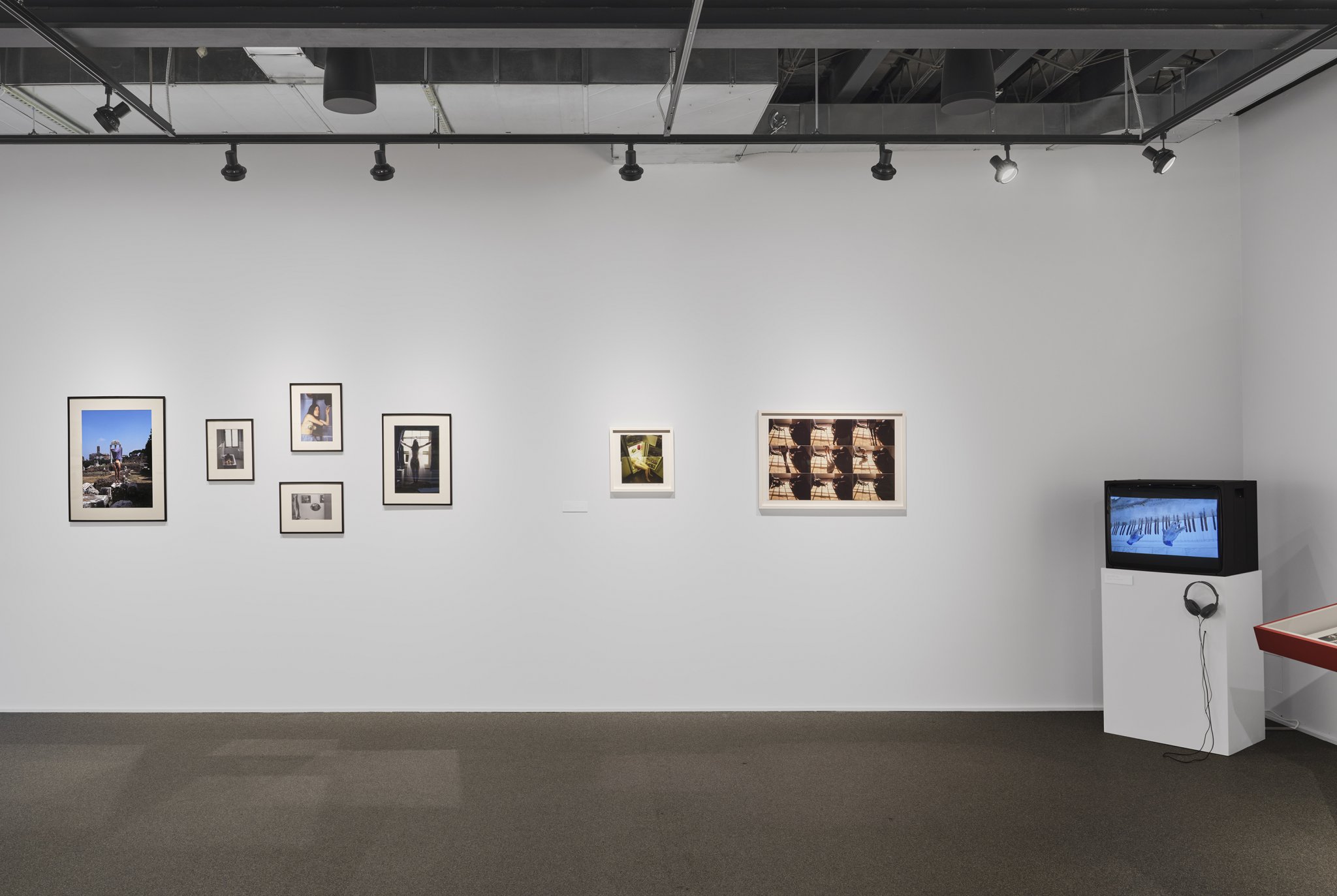
Karen Lamassonne: Ruido / Noise, installation view
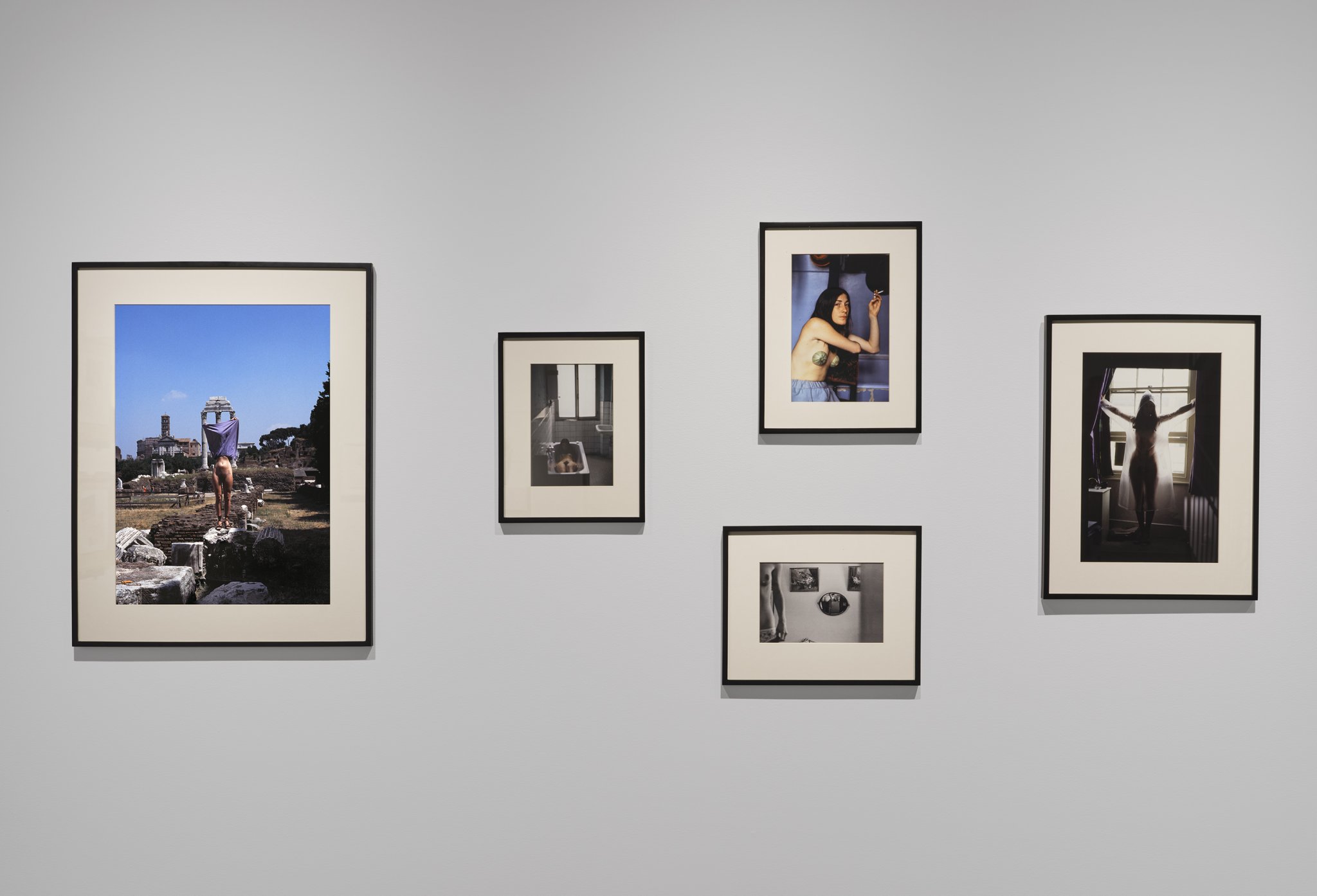
Karen Lamassonne: Ruido / Noise, installation view
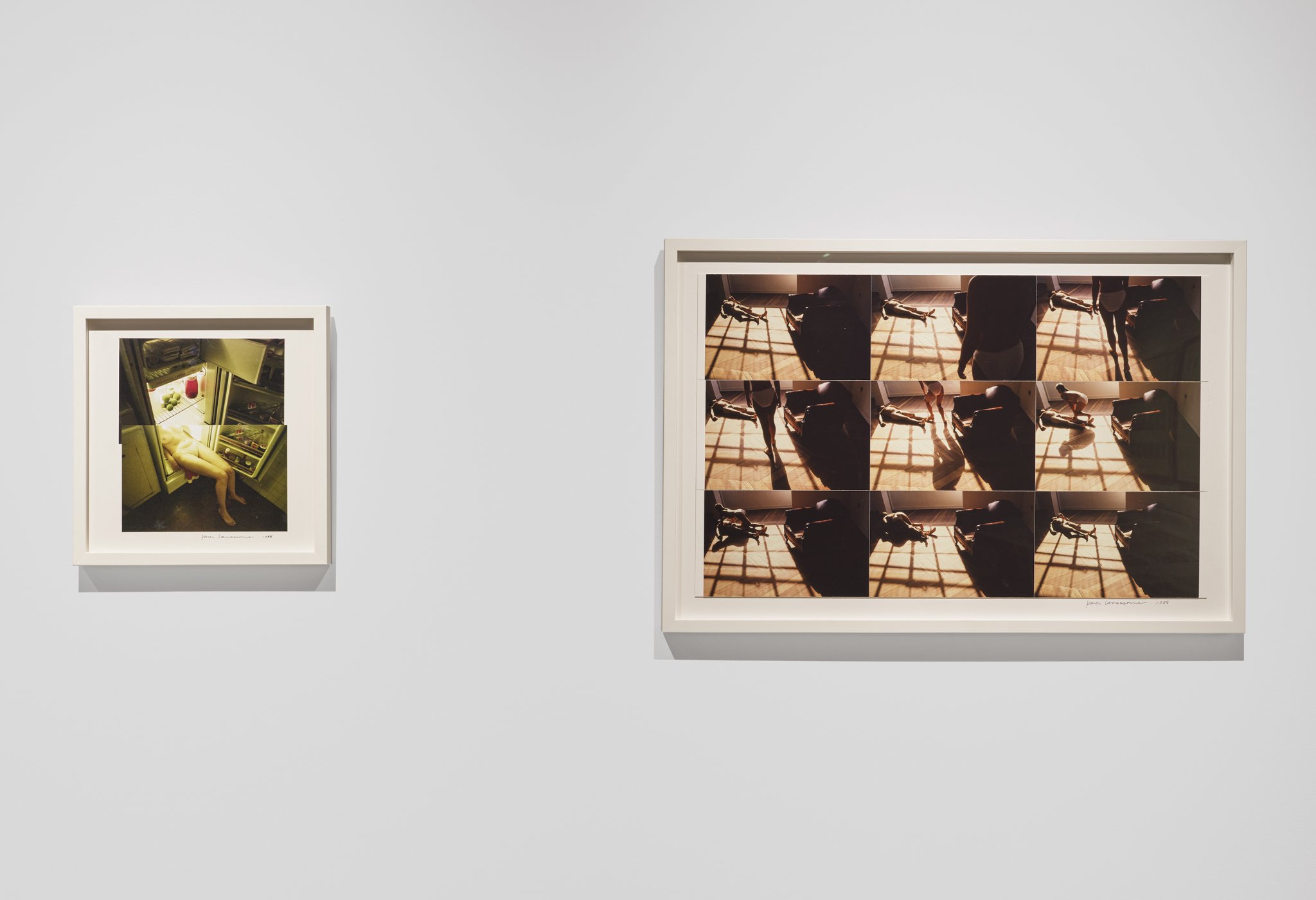
Karen Lamassonne:
Ruido / Noise, installation view
Lamassonne always drew from life to make her early paintings, using models, mirrors or her own body. In 1978 she had a camera for the first time and made numerous self-portraits, some of which recall motifs from her early paintings, such as the body in the bath. Several of the portraits have a comic note to them, such as the photograph of the artist with her head in a refrigerator or wearing an improvised garment made from a watermelon.
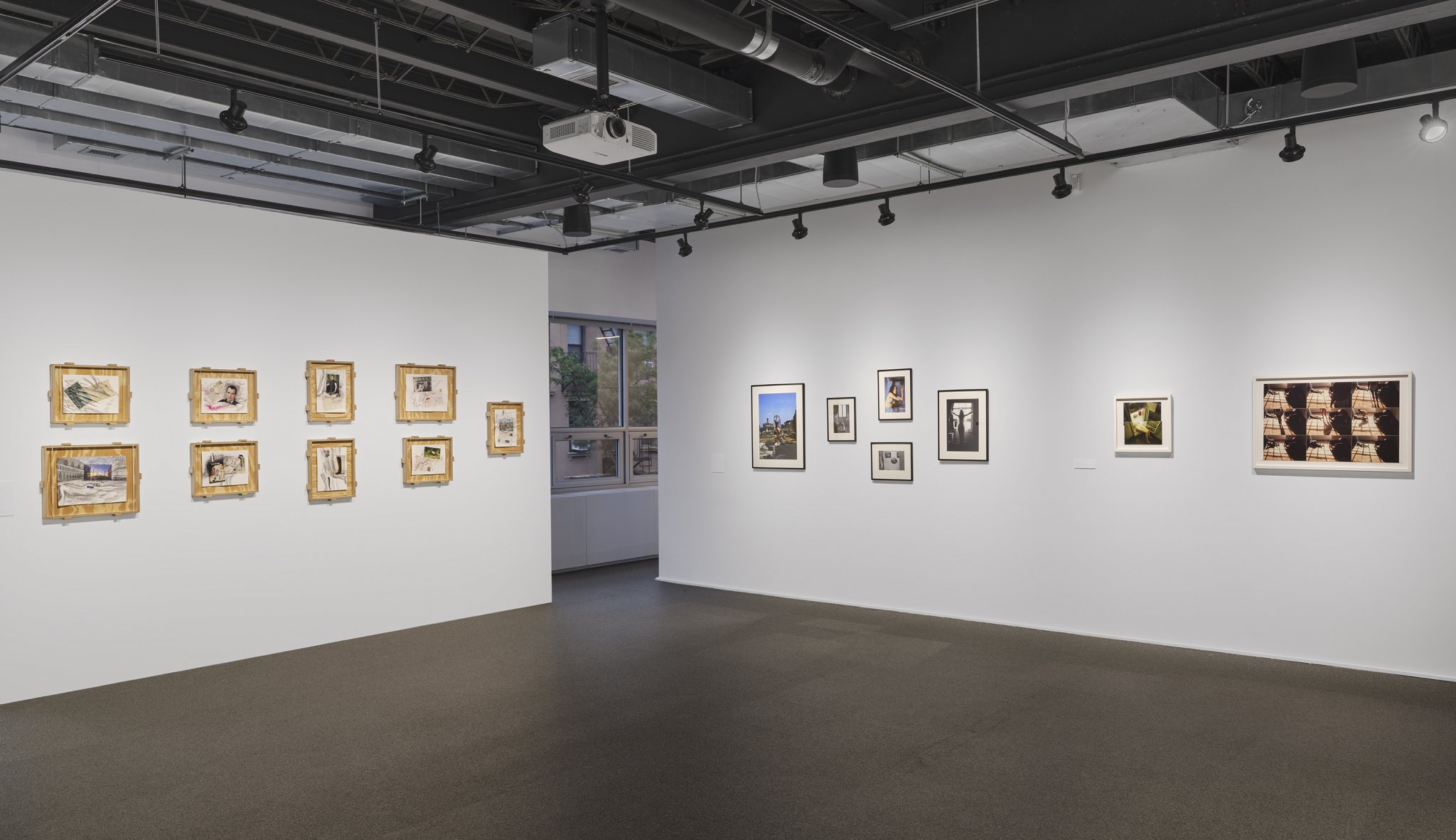
Karen Lamassonne: Ruido / Noise, installation view
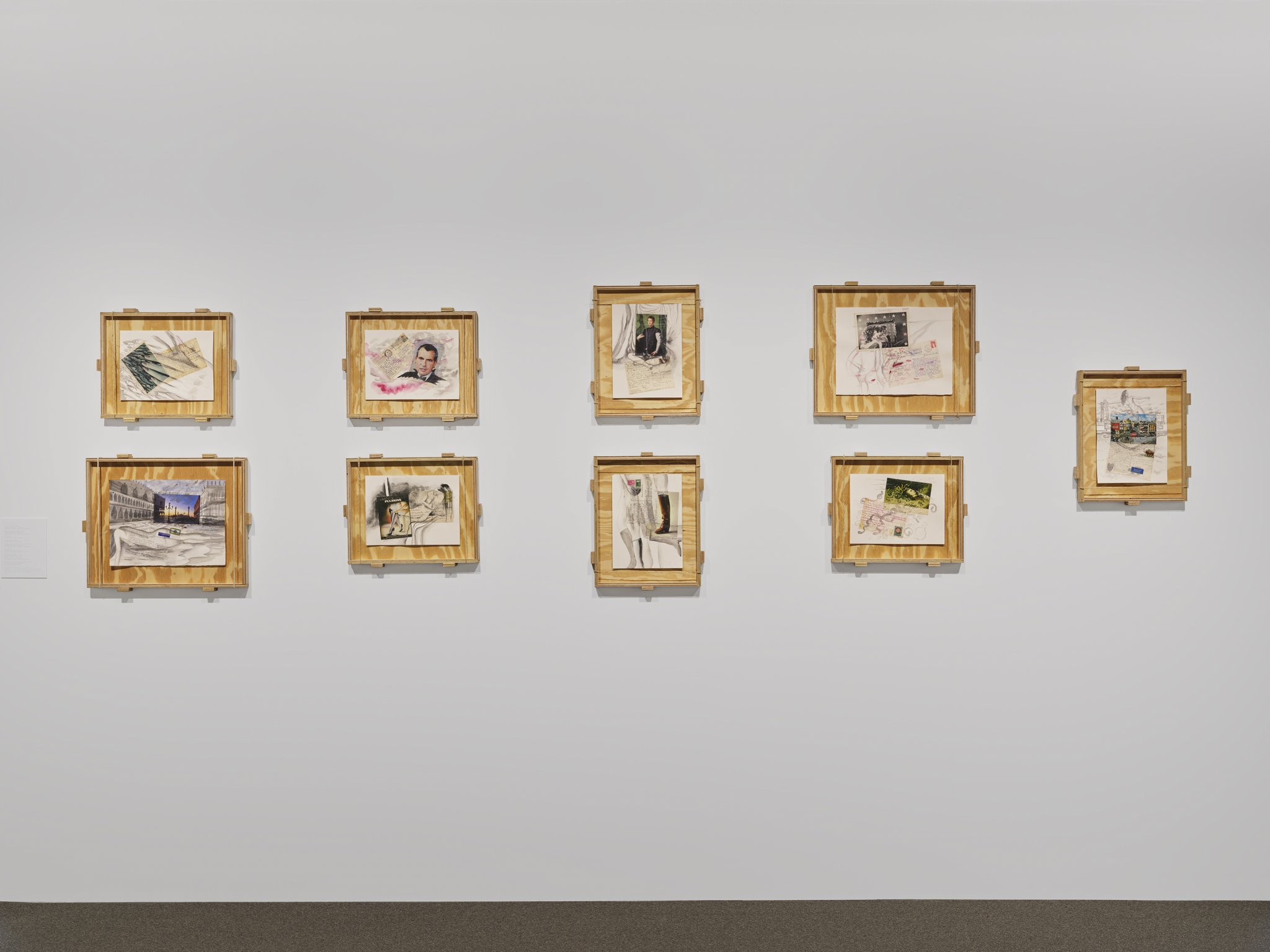
Karen Lamassonne:
Ruido / Noise, installation view
Following the 2019 death of Luis Ospina, who was Lamassonne’s partner for many years, the artist began revisiting her archive of postcards. During lockdown periods of 2020 she began to extend the imagery on the front of the cards in surreal and surprising
directions.
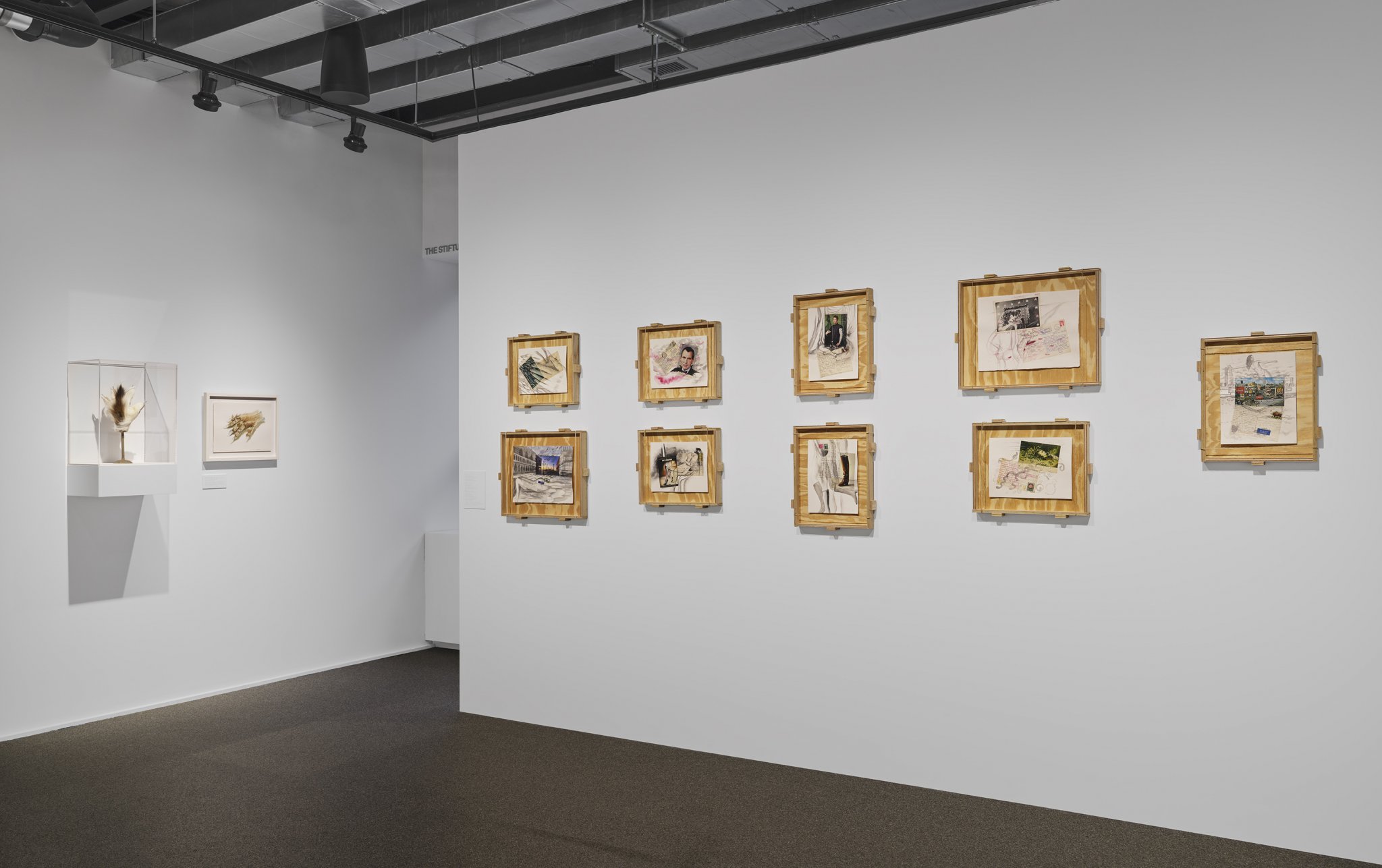
Karen Lamassonne: Ruido / Noise, installation view
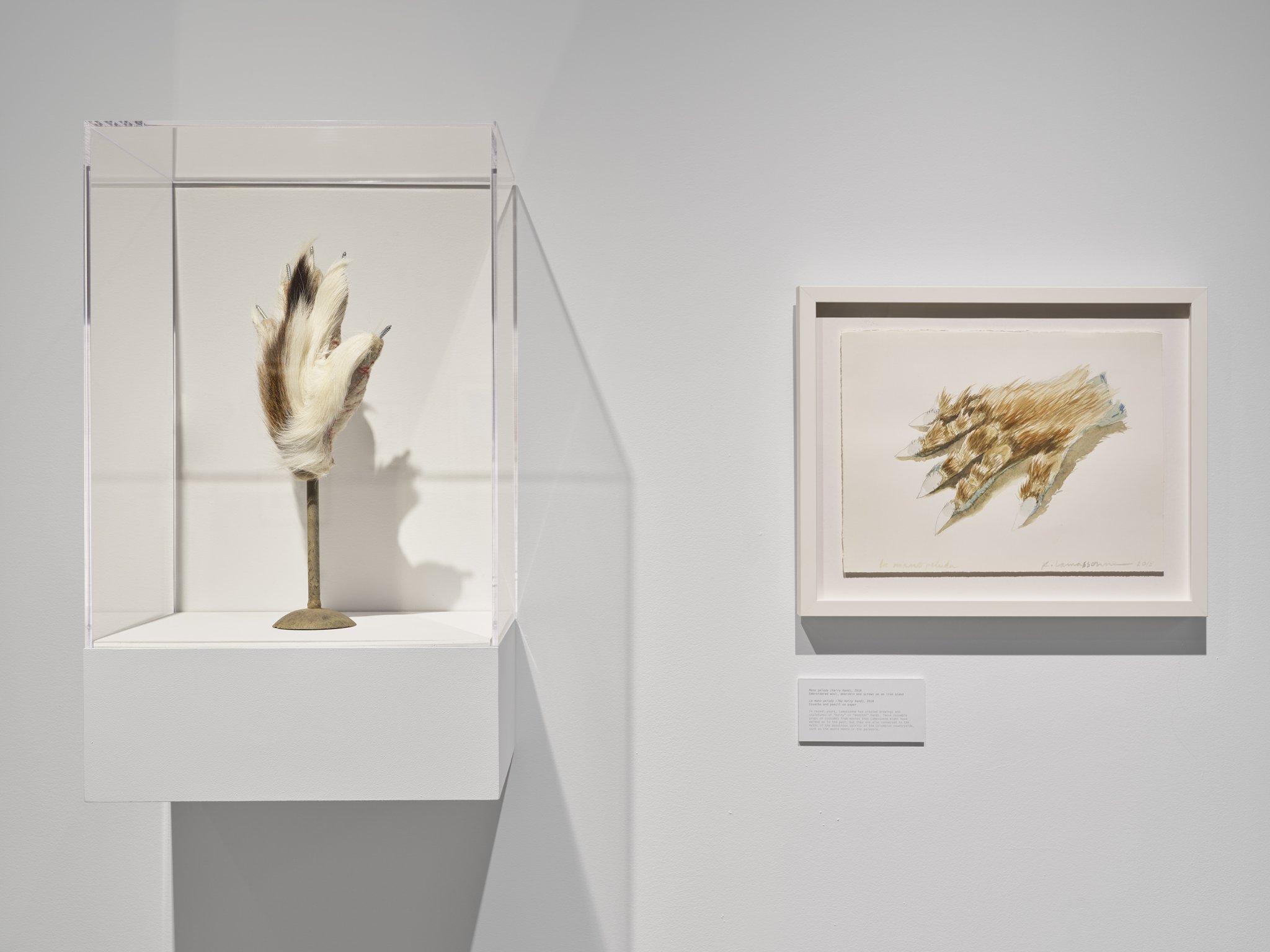
(from left)
Mano peluda (Hairy Hand), 2018. Embroidered wool, deerskin and screws on an iron stand.
La mano peluda (The Hairy Hand), 2018. Gouache and pencil on paper.
In recent years, Lamassonne has created drawings and sculptures of “hairy” or “monster” hands. These resemble props or costumes from movies that Lamassonne might have worked on in the past, but they are also connected to the myths of the monstrous spirits of the Colombian countryside, such as the
madre monte or the
patasola.

![]()
































